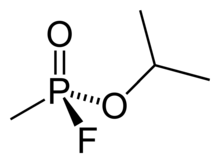Chemical warfare
| Part of a series on | |||||
| Chemical agents | |||||
|---|---|---|---|---|---|
| Lethal agents | |||||
|
|||||
|
|||||
| Incapacitating agents | |||||
|
|||||
| Weapons of mass destruction |
|---|
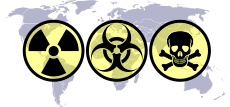 |
| By type |
| By country |
|
| Proliferation |
| Treaties |
|
Chemical warfare (CW) involves using the toxic properties of chemical substances as weapons. This type of warfare is distinct from nuclear warfare and biological warfare, which together make up NBC, the military acronym for nuclear, biological, and chemical (warfare or weapons), all of which are considered "weapons of mass destruction" (WMDs). None of these fall under the term conventional weapons which are primarily effective due to their destructive potential. With proper protective equipment, training, and decontamination measures, the primary effects of chemical weapons can be overcome. Many nations possess vast stockpiles of weaponized agents in preparation for wartime use. The threat and the perceived threat have become strategic tools in planning both measures and counter-measures.
The use of chemical weapons is prohibited under customary international humanitarian law.[1]
Definition
Chemical warfare is different from the use of conventional weapons or nuclear weapons because the destructive effects of chemical weapons are not primarily due to any explosive force. The offensive use of living organisms (such as anthrax) is considered biological warfare rather than chemical warfare; however, the use of nonliving toxic products produced by living organisms (e.g. toxins such as botulinum toxin, ricin, and saxitoxin) is considered chemical warfare under the provisions of the Chemical Weapons Convention (CWC). Under this Convention, any toxic chemical, regardless of its origin, is considered a chemical weapon unless it is used for purposes that are not prohibited (an important legal definition known as the General Purpose Criterion).[2]
About 70 different chemicals have been used or stockpiled as chemical warfare agents during the 20th century. The entire class known as Lethal Unitary Chemical Agents and Munitions have been scheduled for elimination by the CWC.[3]
Under the Convention, chemicals that are toxic enough to be used as chemical weapons, or that may be used to manufacture such chemicals, are divided into three groups according to their purpose and treatment:
- Schedule 1 – Have few, if any, legitimate uses. These may only be produced or used for research, medical, pharmaceutical or protective purposes (i.e. testing of chemical weapons sensors and protective clothing). Examples include nerve agents, ricin, lewisite and mustard gas. Any production over 100 g must be reported to the OPCW and a country can have a stockpile of no more than one tonne of these chemicals.
- Schedule 2 – Have no large-scale industrial uses, but may have legitimate small-scale uses. Examples include dimethyl methylphosphonate, a precursor to sarin also used as a flame retardant, and thiodiglycol, a precursor chemical used in the manufacture of mustard gas but also widely used as a solvent in inks.
- Schedule 3 – Have legitimate large-scale industrial uses. Examples include phosgene and chloropicrin. Both have been used as chemical weapons but phosgene is an important precursor in the manufacture of plastics and chloropicrin is used as a fumigant. The OPCW must be notified of, and may inspect, any plant producing more than 30 tons per year.
History
Ancient and medieval times
Ancient Greek myths about Hercules poisoning his arrows with the venom of the Hydra monster are the earliest references to toxic weapons in western literature. Homer's epics, the Iliad and the Odyssey, allude to poisoned arrows used by both sides in the legendary Trojan War (Bronze Age Greece).[4]
Some of the earliest surviving references to toxic warfare appear in the Indian epics Ramayana and Mahabharata.[5] The "Laws of Manu," a Hindu treatise on statecraft (c. 400 BC) forbids the use of poison and fire arrows, but advises poisoning food and water. Kautilya's "Arthashastra", a statecraft manual of the same era, contains hundreds of recipes for creating poison weapons, toxic smokes, and other chemical weapons. Ancient Greek historians recount that Alexander the Great encountered poison arrows and fire incendiaries in India at the Indus basin in the 4th century BC.[4]

Arsenical smokes were known to the Chinese as far back as c. 1000 BC[6] and Sun Tzu's "Art of War" (c. 200 BC) advises the use of fire weapons. In the second century BC, writings of the Mohist sect in China describe the use of bellows to pump smoke from burning balls of toxic plants and vegetables into tunnels being dug by a besieging army. Other Chinese writings dating around the same period contain hundreds of recipes for the production of poisonous or irritating smokes for use in war along with numerous accounts of their use. These accounts describe an arsenic-containing "soul-hunting fog", and the use of finely divided lime dispersed into the air to suppress a peasant revolt in 178 AD.
The earliest recorded use of gas warfare in the West dates back to the fifth century BC, during the Peloponnesian War between Athens and Sparta. Spartan forces besieging an Athenian city placed a lighted mixture of wood, pitch, and sulfur under the walls hoping that the noxious smoke would incapacitate the Athenians, so that they would not be able to resist the assault that followed. Sparta was not alone in its use of unconventional tactics in ancient Greece; Solon of Athens is said to have used hellebore roots to poison the water in an aqueduct leading from the River Pleistos around 590 BC during the siege of Kirrha.[4]
The earliest archaeological evidence of gas warfare is during the Roman–Persian wars. Research carried out on the collapsed tunnels at Dura-Europos in Syria suggests that during the siege of the town in the third century AD, the Sassanians used bitumen and sulfur crystals to get it burning. When ignited, the materials gave off dense clouds of choking sulfur dioxide gases which killed 19 Roman soldiers and a single Sassanian, purported to be the fire-tender, in a matter of two minutes.[7][8][9][10]
Quicklime (the old name for calcium oxide) may have been used in medieval naval warfare - up to the use of "lime-mortars" to throw it at the enemy ships.[11] Historian and philosopher David Hume, in his history of England, recounts how in the reign of Henry III (r.1216 - 1272) the English Navy destroyed an invading French fleet, by blinding the enemy fleet with quicklime. D’Albiney employed a stratagem against them, which is said to have contributed to the victory: Having gained the wind of the French, he came down upon them with violence; and gassing a great quantity of quicklime, which he purposely carried on board, he so blinded them, that they were disabled from defending themselves.[12]
In the late 15th century, Spanish conquistadors encountered a rudimentary type of chemical warfare on the island of Hispaniola. The Taíno threw gourds filled with ashes and ground hot peppers at the Spaniards to create a blinding smoke screen before launching their attack.[13]
Early modern era

Leonardo da Vinci proposed the use of a powder of sulfide, arsenic and verdigris in the 15th century:
- throw poison in the form of powder upon galleys. Chalk, fine sulfide of arsenic, and powdered verdegris may be thrown among enemy ships by means of small mangonels, and all those who, as they breathe, inhale the powder into their lungs will become asphyxiated.
It is unknown whether this powder was ever actually used.
In the 17th century during sieges, armies attempted to start fires by launching incendiary shells filled with sulfur, tallow, rosin, turpentine, saltpeter, and/or antimony. Even when fires were not started, the resulting smoke and fumes provided a considerable distraction. Although their primary function was never abandoned, a variety of fills for shells were developed to maximize the effects of the smoke.
In 1672, during his siege of the city of Groningen, Christoph Bernhard von Galen, the Bishop of Münster, employed several different explosive and incendiary devices, some of which had a fill that included Deadly Nightshade, intended to produce toxic fumes. Just three years later, August 27, 1675, the French and the Holy Roman Empire concluded the Strasbourg Agreement, which included an article banning the use of "perfidious and odious" toxic devices.
Industrial era
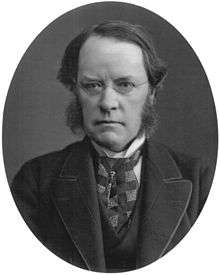
The modern notion of chemical warfare emerged from the mid-19th century, with the development of modern chemistry and associated industries. The first proposal for the use of chemical warfare was made by Lyon Playfair, Secretary of the Science and Art Department, in 1854 during the Crimean War. He proposed a cacodyl cyanide artillery shell for use against enemy ships as way to solve the stalemate during the siege of Sevastopol. The proposal was backed by Admiral Thomas Cochrane of the Royal Navy. It was considered by the Prime Minister, Lord Palmerston, but the British Ordnance Department rejected the proposal as "as bad a mode of warfare as poisoning the wells of the enemy." Playfair’s response was used to justify chemical warfare into the next century: [14]
- There was no sense in this objection. It is considered a legitimate mode of warfare to fill shells with molten metal which scatters among the enemy, and produced the most frightful modes of death. Why a poisonous vapor which would kill men without suffering is to be considered illegitimate warfare is incomprehensible. War is destruction, and the more destructive it can be made with the least suffering the sooner will be ended that barbarous method of protecting national rights. No doubt in time chemistry will be used to lessen the suffering of combatants, and even of criminals condemned to death.
Later, during the American Civil War, New York school teacher John Doughty proposed the offensive use of chlorine gas, delivered by filling a 10-inch (254 millimeter) artillery shell with two to three quarts (1.89–2.84 liters) of liquid chlorine, which could produce many cubic feet of chlorine gas. Doughty’s plan was apparently never acted on, as it was probably[15] presented to Brigadier General James Wolfe Ripley, Chief of Ordnance, who was described as being congenitally immune to new ideas.
A general concern over the use of poison gas manifested itself in 1899 at the Hague Conference with a proposal prohibiting shells filled with asphyxiating gas. The proposal was passed, despite a single dissenting vote from the United States. The American representative, Navy Captain Alfred Thayer Mahan, justified voting against the measure on the grounds that "the inventiveness of Americans should not be restricted in the development of new weapons."
World War I


The Hague Declaration of 1899 and the Hague Convention of 1907 forbade the use of "poison or poisoned weapons" in warfare, yet more than 124,000 tons of gas were produced by the end of World War I.
The French were the first to use chemical weapons during the First World War, using the tear gases ethyl bromoacetate and chloroacetone. They likely did not realize that effects might be more serious under wartime conditions than in riot control. It is also likely that their use of tear gas escalated to the use of poisonous gases.[16]
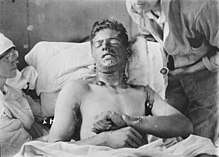
One of Germany's earliest uses of chemical weapons occurred on October 27, 1914, when shells containing the irritant dianisidine chlorosulfonate were fired at British troops near Neuve-Chapelle, France.[6] Germany used another irritant, xylyl bromide, in artillery shells that were fired in January 1915 at the Russians near Bolimów, in present-day Poland.[17] The first full-scale deployment of deadly chemical warfare agents during World War I was at the Second Battle of Ypres, on April 22, 1915, when the Germans attacked French, Canadian and Algerian troops with chlorine gas.[18][19][20]
A total 50,965 tons of pulmonary, lachrymatory, and vesicant agents were deployed by both sides of the conflict, including chlorine, phosgene, and mustard gas. Official figures declare about 1.3 million casualties directly caused by chemical warfare agents during the course of the war. Of these, an estimated 100,000-260,000 casualties were civilians. Nearby civilian towns were at risk from winds blowing the poison gases through. Civilians rarely had a warning system put into place to alert their neighbors of the danger. In addition to poor warning systems, civilians often did not have access to effective gas masks.[21][22][20]
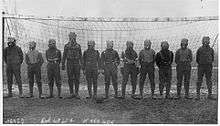
World War I-era chemical ammunition is still found, unexploded, at former battle, storage, or test sites and poses an ongoing threat to inhabitants of Belgium, France and other countries.[23] Camp American University where American chemical weapons were developed and later buried, has undergone 20 years of remediation efforts.[24][25]
After the war, the most common method of disposal of chemical weapons was to dump them into the nearest large body of water.[26] As many as 65,000 tons of chemical warfare agents may have been dumped in the Baltic Sea alone; agents dumped in that sea included mustard gas, phosgene, lewisite (β-chlorovinyldichloroarsine), adamsite (diphenylaminechloroarsine), Clark I (diphenylchloroarsine) and Clark II (diphenylcyanoarsine).[27][28][29] Over time the containers corrode, and the chemicals leaked out. On the sea floor, at low temperatures, mustard gas tends to form lumps within a "skin" of chemical byproducts. These lumps can wash onto shore, where they look like chunks of waxy yellowish clay. They are extremely toxic, but the effects may not be immediately apparent.[26]
Interwar years
Between World War I and World War II, chemical agents were occasionally used to subdue populations and suppress rebellion.
Lenin's Soviet government employed poison gas in 1921 during the Tambov Rebellion. An order signed by military commanders Tukhachevsky and Vladimir Antonov-Ovseyenko stipulated: "The forests where the bandits are hiding are to be cleared by the use of poison gas. This must be carefully calculated, so that the layer of gas penetrates the forests and kills everyone hiding there."[30][31]
During the Rif War in Spanish Morocco in 1921–1927, combined Spanish and French forces dropped mustard gas bombs in an attempt to put down the Berber rebellion. (See also: Chemical weapons in the Rif War)
In 1925, 16 of the world's major nations signed the Geneva Protocol, thereby pledging never to use gas in warfare again. Notably, while the United States delegation under Presidential authority signed the Protocol, it languished in the U.S. Senate until 1975, when it was finally ratified.
Use by Italians in Libya and Ethiopia
In violation of the Geneva Protocol,[32] Italy used mustard gas and other "gruesome measures" against Senussi forces in Libya (see Pacification of Libya, Italian colonization of Libya).[33] Poison gas was used against the Libyans as early as January 1928 [32] The Italians dropped mustard gas from the air.[34]
Beginning in October 1935 and continuing into the following months Fascist Italy used mustard gas against the Ethiopians during the Second Italo-Abyssinian War in violation of the Geneva Protocol. Italian general Rodolfo Graziani first ordered the use of chemical weapons at Gorrahei against the forces of Ras Nasibu.[35] Benito Mussolini personally authorized Graziani to use chemical weapons.[36] Chemical weapons dropped by warplane "proved to be very effective" and was used "on a massive scale against civilians and troops, as well as to contaminate fields and water supplies."[37] Among the most intense chemical bombardment by the Italian Air Force in Ethiopia occurred in February and March 1936, although "gas warfare continued, with varying intensity, until March 1939."[36] J. F. C. Fuller, who was present in Ethiopia during the conflict, stated that mustard gas "was the decisive tactical factor in the war."[38] Some estimate that up to one-third of Ethiopian casualties of the war were caused by chemical weapons.[39]
The Italians' deployment of mustard gas prompted international criticism.[35][38] In April 1936, British Prime Minister Stanley Baldwin told Parliament: "If a great European nation, in spite of having given its signature to the Geneva Protocol against the use of such gases, employs them in Africa, what guarantee have we that they may not be used in Europe?"[38][40] Mussolini initially denied the use of chemical weapons; later, Mussolini and Italian government sought to justify their use as lawful retaliation for Ethiopian atrocities.[35][36][38]
After the liberation of Ethiopia in 1941, Ethiopia repeatedly but unsuccessfully sought to prosecute Italian war criminals. The Allied powers excluded Ethiopia from the United Nations War Crimes Commission (established 1942) because the British feared that Ethiopia would seek to prosecute Pietro Badoglio, who had ordered the use of chemical gas in the Second Italo-Abyssinian War, but later "became a valuable ally against the Axis powers" after the fascist regime of Mussolini fell and Italy switched sides to join the Allied powers.[35] In 1946, the Ethiopians under Haile Selassie again sought "to prosecute senior Italian officials who had sanctioned the use of chemical weapons and had omitted other war crimes such as torturing and executing Ethiopian prisoners and citizens during the Italian-Ethiopian War."[35] These attempts failed, in large part because Britain and the U.S. wished to avoid alienating the Italian government at a time when Italy was seen as key to containing the Soviet Union.[35]
Following World War II, the Italian government denied that Italy had ever used chemical weapons in Africa; only in 1995 did Italy formally acknowledge that it had used chemical weapons in colonial wars.[41]
Nerve agents
Shortly after the end of World War I, Germany's General Staff enthusiastically pursued a recapture of their preeminent position in chemical warfare. In 1923, Hans von Seeckt pointed the way, by suggesting that German poison gas research move in the direction of delivery by aircraft in support of mobile warfare. Also in 1923, at the behest of the German army, poison gas expert Dr. Hugo Stoltzenberg negotiated with the USSR to build a huge chemical weapons plant at Trotsk, on the Volga river.
Collaboration between Germany and the USSR in poison gas continued on and off through the 1920s. In 1924, German officers debated the use of poison gas versus non-lethal chemical weapons against civilians.
Chemical warfare was revolutionized by Nazi Germany's discovery of the nerve agents tabun (in 1937) and sarin (in 1939) by Gerhard Schrader, a chemist of IG Farben.
IG Farben was Germany's premier poison gas manufacturer during World War II, so the weaponization of these agents cannot be considered accidental.[42] Both were turned over to the German Army Weapons Office prior to the outbreak of the war.
The nerve agent soman was later discovered by Nobel Prize laureate Richard Kuhn and his collaborator Konrad Henkel at the Kaiser Wilhelm Institute for Medical Research in Heidelberg in spring 1944.[43][44] The Germans developed and manufactured large quantities of several agents, but chemical warfare was not extensively used by either side. Chemical troops were set up (in Germany since 1934) and delivery technology was actively developed.
World War II
Imperial Japanese Army
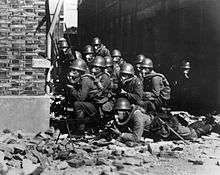
Despite the 1899 Hague Declaration IV, 2 - Declaration on the Use of Projectiles the Object of Which is the Diffusion of Asphyxiating or Deleterious Gases,[45] Article 23 (a) of the 1907 Hague Convention IV - The Laws and Customs of War on Land,[46] and a resolution adopted against Japan by the League of Nations on May 14, 1938, the Imperial Japanese Army frequently used chemical weapons. Because of fear of retaliation, however, those weapons were never used against Westerners, but against other Asians judged "inferior" by imperial propaganda. According to historians Yoshiaki Yoshimi and Kentaro Awaya, gas weapons, such as tear gas, were used only sporadically in 1937 but in early 1938, the Imperial Japanese Army began full-scale use of sneeze and nausea gas (red), and from mid-1939, used mustard gas (yellow) against both Kuomintang and Communist Chinese troops.[47]
According to historians Yoshiaki Yoshimi and Seiya Matsuno, the chemical weapons were authorized by specific orders given by Emperor Hirohito himself, transmitted by the chief of staff of the army. For example, the Emperor authorized the use of toxic gas on 375 separate occasions during the Battle of Wuhan from August to October 1938.[48] They were also profusely used during the invasion of Changde. Those orders were transmitted either by prince Kotohito Kan'in or general Hajime Sugiyama.[49] The Imperial Japanese Army had used mustard gas and the US-developed (CWS-1918) blister agent lewisite against Chinese troops and guerrillas. Experiments involving chemical weapons were conducted on live prisoners (Unit 731 and Unit 516).
The Japanese also carried chemical weapons as they swept through Southeast Asia towards Australia. Some of these items were captured and analyzed by the Allies. Historian Geoff Plunkett has recorded how Australia covertly imported 1,000,000 chemical weapons from the United Kingdom from 1942 onwards and stored them in many storage depots around the country, including three tunnels in the Blue Mountains to the west of Sydney. They were to be used as a retaliatory measure if the Japanese first used chemical weapons.[50] Buried chemical weapons have been recovered at Marrangaroo and Columboola.[51][52]
Nazi Germany
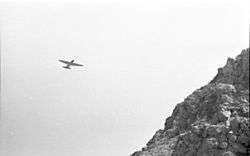
During the Holocaust, a genocide perpetrated by Nazi Germany, millions of Jews and other victims were gassed with carbon monoxide and hydrogen cyanide (including Zyklon B).[53][54] This remains the deadliest use of poison gas in history.[53] Nevertheless, the Nazis did not extensively use chemical weapons in combat,[53][54] at least not against the Western Allies,[55] despite maintaining an active chemical weapons program in which the Nazis used concentration camp prisoners as forced labor to secretly manufacture tabun, a nerve gas, and experimented upon concentration camp victims to test the effects of the gas.[53] Otto Ambros of IG Farben was a chief chemical-weapons expert for the Nazis.[53][56]
The Nazis' decision to avoid the use of chemical weapons on the battlefield has been variously attributed to a lack of technical ability in the German chemical weapons program and fears that the Allies would retaliate with their own chemical weapons.[55] It also has been speculated to have arisen from the personal experiences of Adolf Hitler as a soldier in the Kaiser's army during World War I, where he was gassed by British troops in 1918.[57] After the Battle of Stalingrad, Joseph Goebbels, Robert Ley, and Martin Bormann urged Hitler to approve the use of tabun and other chemical weapons to slow the Soviet advance. At a May 1943 meeting in the Wolf's Lair, however, Hitler was told by Ambros that Germany had 45,000 tons of chemical gas stockpiled, but that the Allies likely had far more. Hitler responded by suddenly leaving the room and ordering production of tabun and sarin to be doubled, but "fearing some rogue officer would use them and spark Allied retaliation, he ordered that no chemical weapons be transported to the Russian front."[53] After the Allied invasion of Italy, the Germans rapidly moved to remove or destroy both German and Italian chemical-weapon stockpiles, "for the same reason that Hitler had ordered them pulled from the Russian front—they feared that local commanders would use them and trigger Allied chemical retaliation."[53]
Stanley P. Lovell, Deputy Director for Research and Development of the Office of Strategic Services, reports in his book Of Spies and Stratagems that the Allies knew the Germans had quantities of Gas Blau available for use in the defense of the Atlantic Wall. The use of nerve gas on the Normandy beachhead would have seriously impeded the Allies and possibly caused the invasion to fail altogether. He submitted the question "Why was nerve gas not used in Normandy?" to be asked of Hermann Göring during his interrogation. Göring answered that the reason was that the Wehrmacht was dependent upon horse-drawn transport to move supplies to their combat units, and had never been able to devise a gas mask horses could tolerate; the versions they developed would not pass enough pure air to allow the horses to pull a cart. Thus, gas was of no use to the German Army under most conditions.[58]
The Nazis did use chemical weapons in combat on several occasions along the Black Sea, notably in Sevastopol, where they used toxic smoke to force Russian resistance fighters out of caverns below the city, in violation of the 1925 Geneva Protocol.[59] The Nazis also used asphyxiating gas in the catacombs of Odessa in November 1941, following their capture of the city, and in late May 1942 during the Battle of the Kerch Peninsula in eastern Crimea.[59] Victor Israelyan, a Soviet ambassador, reported that the latter incident was perpetrated by the Wehrmacht's Chemical Forces and organized by a special detail of SS troops with the help of a field engineer battalion. Chemical Forces General Ochsner reported to German command in June 1942 that a chemical unit had taken part in the battle.[60] After the battle in mid-May 1942, roughly 3,000 Red Army soldiers and Soviet civilians not evacuated by sea were besieged in a series of caves and tunnels in the nearby Adzhimuskai quarry. After holding out for approximately three months, "poison gas was released into the tunnels, killing all but a few score of the Soviet defenders."[61] Thousands of those killed around Adzhimushk were documented to have been killed by asphyxiation from gas.[60]
In February 1943, German troops stationed in Kuban received a telegram: "Russians should be eventually cleared out of the mountain range with gas."[62] The troops also received two wagons of toxin antidotes.[62]
Western Allies
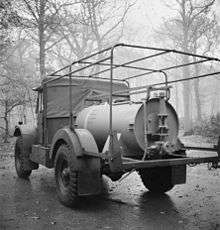
The Western Allies did not use chemical weapons during the Second World War. The British planned to use mustard gas and phosgene to help repel a German invasion in 1940-1941,[63][64] and had there been an invasion may have also deployed it against German cities.[65] General Alan Brooke, Commander-in-Chief, Home Forces, in command of British anti-invasion preparations of the Second World War said that he "...had every intention of using sprayed mustard gas on the beaches" in an annotation in his diary.[66] The British manufactured mustard, chlorine, lewisite, phosgene and Paris Green and stored them at airfields and depots for use on the beaches.[65]
The mustard gas stockpile was enlarged in 1942–1943 for possible use by RAF Bomber Command against German cities, and in 1944 for possible retaliatory use if German forces used chemical weapons against the D-Day landings.[63]
Winston Churchill, the British Prime Minister, issued a memorandum advocating a chemical strike on German cities using poison gas and possibly anthrax. Although the idea was rejected, it has provoked debate.[67] In July 1944, fearing that rocket attacks on London would get even worse, and saying he would only use chemical weapons if it were "life or death for us" or would "shorten the war by a year",[68] Churchill wrote a secret memorandum asking his military chiefs to "think very seriously over this question of using poison gas." He stated "it is absurd to consider morality on this topic when everybody used it in the last war without a word of complaint..."
The Joint Planning Staff, however, advised against the use of gas because it would inevitably provoke Germany to retaliate with gas. They argued that this would be to the Allies' disadvantage in France both for military reasons and because it might "seriously impair our relations with the civilian population when it became generally known that chemical warfare was first employed by us."[69]
In 1945, the U.S. Army's Chemical Warfare Service standardized improved chemical warfare rockets intended for the new M9 and M9A1 'Bazooka' launchers, adopting the M26 Gas Rocket, a cyanogen chloride (CK)-filled warhead for the 2.36-in rocket launcher.[70] CK, a deadly blood agent, was capable of penetrating the protective filter barriers in some gas masks,[71] and was seen as an effective agent against Japanese forces (particularly those hiding in caves or bunkers), whose gas masks lacked the impregnants that would provide protection against the chemical reaction of CK.[70][72][73] While stockpiled in US inventory, the CK rocket was never deployed or issued to combat personnel.[70]
Accidental release
On the night of December 2, 1943, German Ju 88 bombers attacked the port of Bari in Southern Italy, sinking several American ships—among them the SS John Harvey, which was carrying mustard gas intended for use in retaliation by the Allies if German forces initiated gas warfare. The presence of the gas was highly classified, and authorities ashore had no knowledge of it, which increased the number of fatalities since physicians, who had no idea that they were dealing with the effects of mustard gas, prescribed treatment improper for those suffering from exposure and immersion.
The whole affair was kept secret at the time and for many years after the war. According to the U.S. military account, "Sixty-nine deaths were attributed in whole or in part to the mustard gas, most of them American merchant seamen"[74] out of 628 mustard gas military casualties.[75]
The large number of civilian casualties among the Italian population was not recorded. Part of the confusion and controversy derives from the fact that the German attack was highly destructive and lethal in itself, also apart from the accidental additional effects of the gas (the attack was nicknamed "The Little Pearl Harbor"), and attribution of the causes of death between the gas and other causes is far from easy.[76][77] Rick Atkinson, in his book The Day of Battle, describes the intelligence that prompted Allied leaders to deploy mustard gas to Italy. This included Italian intelligence that Adolf Hitler had threatened to use gas against Italy if the state changed sides, and prisoner of war interrogations suggesting that preparations were being made to use a "new, egregiously potent gas" if the war turned decisively against Germany. Atkinson concludes, "No commander in 1943 could be cavalier about a manifest threat by Germany to use gas."
Post-World War II
After World War II, the Allies recovered German artillery shells containing the three German nerve agents of the day (tabun, sarin, and soman), prompting further research into nerve agents by all of the former Allies.
Although the threat of global thermonuclear war was foremost in the minds of most during the Cold War, both the Soviet and Western governments put enormous resources into developing chemical and biological weapons.
Britain
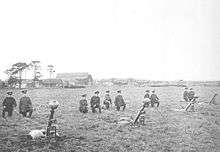
In the late 1940s and early 1950s, British postwar chemical weapons research was based at the Porton Down facility. Research was aimed at providing Britain with the means to arm itself with a modern nerve-agent-based capability and to develop specific means of defense against these agents.
Ranajit Ghosh, a chemist at the Plant Protection Laboratories of Imperial Chemical Industries was investigating a class of organophosphate compounds (organophosphate esters of substituted aminoethanethiols),[78] for use as a pesticide. In 1954, ICI put one of them on the market under the trade name Amiton. It was subsequently withdrawn, as it was too toxic for safe use.
The toxicity did not go unnoticed, and samples of it were sent to the research facility at Porton Down for evaluation. After the evaluation was complete, several members of this class of compounds were developed into a new group of much more lethal nerve agents, the V agents. The best-known of these is probably VX, assigned the UK Rainbow Code Purple Possum, with the Russian V-Agent coming a close second (Amiton is largely forgotten as VG).[79]
On the defensive side, there were years of difficult work to develop the means of prophylaxis, therapy, rapid detection and identification, decontamination and more effective protection of the body against nerve agents, capable of exerting effects through the skin, the eyes and respiratory tract.
Tests were carried out on servicemen to determine the effects of nerve agents on human subjects, with one recorded death due to a nerve gas experiment. There have been persistent allegations of unethical human experimentation at Porton Down, such as those relating to the death of Leading Aircraftman Ronald Maddison, aged 20, in 1953. Maddison was taking part in sarin nerve agent toxicity tests. Sarin was dripped onto his arm and he died shortly afterwards.[80]
In the 1950s the Chemical Defence Experimental Establishment became involved with the development of CS, a riot control agent, and took an increasing role in trauma and wound ballistics work. Both these facets of Porton Down's work had become more important because of the situation in Northern Ireland.[81]
In the early 1950s, nerve agents such as sarin were produced in small quantities—about 20 tons were made from 1954 until 1956. CDE Nancekuke was an important factory for stockpiling chemical weapons. Small amounts of VX were produced there, mainly for laboratory test purposes, but also to validate plant designs and optimise chemical processes for potential mass production. However, full-scale mass production of VX agent never took place, with the 1956 decision to end the UK's offensive chemical weapons programme.[82] In the late 1950s, the chemical weapons production plant at Nancekuke was mothballed, but was maintained through the 1960s and 1970s in a state whereby production of chemical weapons could easily re-commence if required.[82]
United States
In 1952, the U.S. Army patented a process for the "Preparation of Toxic Ricin", publishing a method of producing this powerful toxin. In 1958 the British government traded their VX technology with the United States in exchange for information on thermonuclear weapons. By 1961 the U.S. was producing large amounts of VX and performing its own nerve agent research. This research produced at least three more agents; the four agents (VE, VG, VM, VX) are collectively known as the "V-Series" class of nerve agents.
Between 1951 and 1969, Dugway Proving Ground was the site of testing for various chemical and biological agents, including an open-air aerodynamic dissemination test in 1968 that accidentally killed, on neighboring farms, approximately 6,400 sheep by an unspecified nerve agent.[83]
From 1962 to 1973, the Department of Defense planned 134 tests under Project 112, a chemical and biological weapons "vulnerability-testing program." In 2002, the Pentagon admitted for the first time that some of tests used real chemical and biological weapons, not just harmless simulants.[84]
Specifically under Project SHAD, 37 secret tests were conducted in California, Alaska, Florida, Hawaii, Maryland and Utah. Land tests in Alaska and Hawaii used artillery shells filled with sarin and VX, while Navy trials off the coasts of Florida, California and Hawaii tested the ability of ships and crew to perform under biological and chemical warfare, without the crew's knowledge. The code name for the sea tests was Project Shipboard Hazard and Defense—"SHAD" for short.[84]
In October 2002, the Senate Armed Forces Subcommittee on Personnel held hearings as the controversial news broke that chemical agents had been tested on thousands of American military personnel. The hearings were chaired by Senator Max Cleland, former VA administrator and Vietnam War veteran.
- United States chemical respiratory protection standardization
In December 2001, the United States Department of Health and Human Services, Centers for Disease Control and Prevention (CDC), National Institute for Occupational Safety and Health (NIOSH), and National Personal Protective Technology Laboratory (NPPTL), along with the U.S. Army Research, Development and Engineering Command (RDECOM), Edgewood Chemical and Biological Center (ECBC), and the U.S. Department of Commerce National Institute for Standards and Technology (NIST) published the first of six technical performance standards and test procedures designed to evaluate and certify respirators intended for use by civilian emergency responders to a chemical, biological, radiological, or nuclear weapon release, detonation, or terrorism incident.
To date NIOSH/NPPTL has published six new respirator performance standards based on a tiered approach that relies on traditional industrial respirator certification policy, next-generation emergency response respirator performance requirements, and special live chemical warfare agent testing requirements of the classes of respirators identified to offer respiratory protection against chemical, biological, radiological, and nuclear (CBRN) agent inhalation hazards. These CBRN respirators are commonly known as open-circuit self-contained breathing apparatus (CBRN SCBA), air-purifying respirator (CBRN APR), air-purifying escape respirator (CBRN APER), self-contained escape respirator (CBRN SCER) and loose- or tight-fitting powered air-purifying respirators (CBRN PAPR).
Soviet Union
There were reports of chemical weapons being used during the Soviet–Afghan War, sometimes against civilians.[85][86]
Due to the secrecy of the Soviet Union's government, very little information was available about the direction and progress of the Soviet chemical weapons until relatively recently. After the fall of the Soviet Union, Russian chemist Vil Mirzayanov published articles revealing illegal chemical weapons experimentation in Russia.
In 1993, Mirzayanov was imprisoned and fired from his job at the State Research Institute of Organic Chemistry and Technology, where he had worked for 26 years. In March 1994, after a major campaign by U.S. scientists on his behalf, Mirzayanov was released.[87]
Among the information related by Vil Mirzayanov was the direction of Soviet research into the development of even more toxic nerve agents, which saw most of its success during the mid-1980s. Several highly toxic agents were developed during this period; the only unclassified information regarding these agents is that they are known in the open literature only as "Foliant" agents (named after the program under which they were developed) and by various code designations, such as A-230 and A-232.[88]
According to Mirzayanov, the Soviets also developed weapons that were safer to handle, leading to the development of the binary weapons, in which precursors for the nerve agents are mixed in a munition to produce the agent just prior to its use. Because the precursors are generally significantly less hazardous than the agents themselves, this technique makes handling and transporting the munitions a great deal simpler.
Additionally, precursors to the agents are usually much easier to stabilize than the agents themselves, so this technique also made it possible to increase the shelf life of the agents a great deal. During the 1980s and 1990s, binary versions of several Soviet agents were developed and are designated as "Novichok" agents (after the Russian word for "newcomer").[89] Together with Lev Fedorov, he told the secret Novichok story exposed in the newspaper The Moscow News.[90]
Use in conflicts after World War II
North Yemen
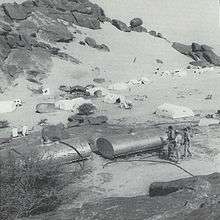
The first attack of the North Yemen Civil War took place on June 8, 1963 against Kawma, a village of about 100 inhabitants in northern Yemen, killing about seven people and damaging the eyes and lungs of 25 others. This incident is considered to have been experimental, and the bombs were described as "home-made, amateurish and relatively ineffective". The Egyptian authorities suggested that the reported incidents were probably caused by napalm, not gas.
There were no reports of gas during 1964, and only a few were reported in 1965. The reports grew more frequent in late 1966. On December 11, 1966, fifteen gas bombs killed two people and injured thirty-five. On January 5, 1967, the biggest gas attack came against the village of Kitaf, causing 270 casualties, including 140 fatalities. The target may have been Prince Hassan bin Yahya, who had installed his headquarters nearby. The Egyptian government denied using poison gas, and alleged that Britain and the US were using the reports as psychological warfare against Egypt. On February 12, 1967, it said it would welcome a UN investigation. On March 1, U Thant, the then Secretary-General of the United Nations, said he was "powerless" to deal with the matter.
On May 10, 1967 the twin villages of Gahar and Gadafa in Wadi Hirran, where Prince Mohamed bin Mohsin was in command, were gas bombed, killing at least seventy-five. The Red Cross was alerted and on June 2, 1967, it issued a statement in Geneva expressing concern. The Institute of Forensic Medicine at the University of Berne made a statement, based on a Red Cross report, that the gas was likely to have been halogenous derivatives—phosgene, mustard gas, lewisite, chloride or cyanogen bromide.
Rhodesian Bush War
Evidence points to a top-secret Rhodesian program in the 1970s to use organophosphate pesticides and heavy metal rodenticides to contaminate clothing as well as food and beverages. The contaminated items were covertly introduced into insurgent supply chains. Hundreds of insurgent deaths were reported, although the actual death toll likely rose over 1,000.[91]
Vietnamese border raids in Thailand
There is some evidence suggesting that Vietnamese troops used phosgene gas against Cambodian resistance forces in Thailand during the 1984-1985 dry-season offensive on the Thai-Cambodian border.[92][93][94]
Iran–Iraq War
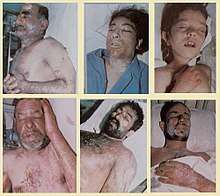
Chemical weapons employed by Saddam Hussein killed and injured numerous Iranians and Iraqi Kurds. According to Iraqi documents, assistance in developing chemical weapons was obtained from firms in many countries, including the United States, West Germany, the Netherlands, the United Kingdom, and France.[95]
About 100,000 Iranian soldiers were victims of Iraq's chemical attacks. Many were hit by mustard gas. The official estimate does not include the civilian population contaminated in bordering towns or the children and relatives of veterans, many of whom have developed blood, lung and skin complications, according to the Organization for Veterans. Nerve gas agents killed about 20,000 Iranian soldiers immediately, according to official reports. Of the 80,000 survivors, some 5,000 seek medical treatment regularly and about 1,000 are still hospitalized with severe, chronic conditions.[96][97][98]
Halabja
In March 1988, the Iraqi Kurdish town of Halabja was exposed to multiple chemical agents dropped from warplanes; these "may have included mustard gas, the nerve agents sarin, tabun and VX and possibly cyanide."[99] Between 3,200 and 5,000 people were killed, and between 7,000 and 10,000 were injured.[99] Some reports indicated that three-quarters of them were women and children.[99] The preponderance of the evidence indicates that Iraq was responsible for the attack.[99]
Persian Gulf War
The U.S. Department of Defense and Central Intelligence Agency's longstanding official position is that Iraqi forces under Saddam Hussein did not use chemical weapons during the Persian Gulf War in 1991. In a memorandum in 1994 to veterans of the war, Defense Secretary William J. Perry and General John M. Shalikashvili, the chairman of the Joint Chiefs of Staff, wrote that "There is no evidence, classified or unclassified, that indicates that chemical or biological weapons were used in the Persian Gulf."[100]
However, chemical weapons expert Jonathan B. Tucker, writing in the Nonproliferation Review in 1997, determined that although "[t]he absence of severe chemical injuries or fatalities among Coalition forces makes it clear that no large-scale Iraqi employment of chemical weapons occurred," an array of "circumstantial evidence from a variety of sources suggests that Iraq deployed chemical weapons into the Kuwait Theater of Operations (KTO)—the area including Kuwait and Iraq south of the 31st Parallel, where the ground war was fought—and engaged in sporadic chemical warfare against Coalition forces."[100] In addition to intercepts of Iraqi military communications and publicly available reporting:
Other sources of evidence for sporadic Iraqi chemical warfare include U.S. intelligence reports on the presence of Iraqi chemical weapons in the KTO; military log entries describing the discovery by U.S. units of chemical munitions in Iraqi bunkers during and after the ground war; incidents in which troops reported acute symptoms of toxic chemical exposure; and credible detections of chemical-warfare agents by Czech, French, and American forces.[100]
Nerve agents (specifically, tabun, sarin, and cyclosarin) and blister agents (specifically, sulfur-mustard and lewisite) were detected at Iraqi sites.[100]
The threat itself of gas warfare had a major effect on Israel, which was not part of the coalition forces led by the US. Israel was attacked with 39 scud missiles, most of which were knocked down in the air above their targets by Patriot missiles developed by Raytheon together with Israel, and supplied by the US. Sirens warned of the attacks approximately 10 minutes before their expected arrival, and Israelis donned gas masks and entered sealed "safe" rooms, over a period 5 weeks. Babies were issued special gas-safe cribs, and religious men were issued gas masks that allowed them to preserve their beards.[101][102][103]
In 2014, tapes from Saddam Hussain's archives revealed that Saddam had given orders to use gas against Israel as a last resort if his military communications with the army were cut off.[104]
In 2015 The New York Times published an article about the declassified report of operation Avarice in 2005 in which over 400 chemical weapons including many rockets and missiles from the Iran-Iraq war period were recovered and subsequently destroyed by the CIA.[105] Many other stockpiles, estimated by UNSCOM up to 600 metric tons of chemical weapons, were known to have existed and even admitted by Saddam's regime, but claimed by them to have been destroyed. These have never been found but are believed to still exist.[106][107]
Angola
During the Cuban intervention in Angola, United Nations toxicologists certified that residue from both VX and sarin nerve agents had been discovered in plants, water, and soil where Cuban units were conducting operations against National Union for the Total Independence of Angola (UNITA) insurgents.[108] In 1985, UNITA made the first of several claims that their forces were the target of chemical weapons, specifically organophosphates. The following year guerrillas reported being bombarded with an unidentified greenish-yellow agent on three separate occasions. Depending on the length and intensity of exposure, victims suffered blindness or death. The toxin was also observed to have killed plant life.[109] Shortly afterwards, UNITA also sighted strikes carried out with a brown agent which it claimed resembled mustard gas.[110] As early as 1984 a research team dispatched by the University of Ghent had examined patients in UNITA field hospitals showing signs of exposure to nerve agents, although it found no evidence of mustard gas.[111]
The UN first accused Cuba of deploying chemical weapons against Angolan civilians and partisans in 1988.[108] Wouter Basson later disclosed that South African military intelligence had long verified the use of unidentified chemical weapons on Angolan soil; this was to provide the impetus for their own biological warfare programme, Project Coast.[108] During the Battle of Cuito Cuanavale, South African troops then fighting in Angola were issued with gas masks and ordered to rehearse chemical weapons drills. Although the status of its own chemical weapons program remained uncertain, South Africa also deceptively bombarded Cuban and Angolan units with colored smoke in an attempt to induce hysteria or mass panic.[110] According to Defence Minister Magnus Malan, this would force the Cubans to share the inconvenience of having to take preventative measures such as donning NBC suits, which would cut combat effectiveness in half. The tactic was effective: beginning in early 1988 Cuban units posted to Angola were issued with full protective gear in anticipation of a South African chemical strike.[110]
On October 29, 1988, personnel attached to Angola's 59 Brigade, accompanied by six Soviet military advisors, reported being struck with chemical weapons on the banks of the Mianei River.[112] The attack occurred shortly after one in the afternoon. Four Angolan soldiers lost consciousness while the others complained of violent headaches and nausea. That November the Angolan representative to the UN accused South Africa of employing poison gas near Cuito Cuanavale for the first time.[112]
Falklands War
Technically, the reported employment of tear gas by Argentine forces during the 1982 invasion of the Falkland Islands constitutes chemical warfare.[113] However, the tear gas grenades were employed as nonlethal weapons to avoid British casualties. The barrack buildings the weapons were used on proved to be deserted in any case. The British claim that more lethal, but legally justifiable as they are not considered chemical weapons under the Chemical Weapons Convention, white phosphorus grenades were used.[114]
Syrian Civil War
Sarin, mustard agent and chlorine gas have been used during the conflict. Numerous casualties led to an international reaction, especially the 2013 Ghouta attacks. A UN fact-finding mission was requested to investigate alleged chemical weapons attacks. In four cases the UN inspectors confirmed use of sarin gas.[115] In August 2016, a confidential report by the United Nations and the OPCW explicitly blamed the Syrian military of Bashar al-Assad for dropping chemical weapons (chlorine bombs) on the towns of Talmenes in April 2014 and Sarmin in March 2015 and ISIS for using sulfur mustard on the town of Marea in August 2015.[116] In 2016, Jaysh al-Islam rebel group had used chlorine gas or other agents against Kurdish militia and civilians in the Sheikh Maqsood neighborhood of Aleppo.[117]
Many countries, including the United States and the European Union have accused the Syrian government of conducting several chemical attacks. Following the 2013 Ghouta attacks and international pressure, Syria acceded to the Chemical Weapons Convention and the destruction of Syria's chemical weapons began. In 2015 the UN mission disclosed previously undeclared traces of sarin compounds in a "military research site".[118] After the April 2017 Khan Shaykhun chemical attack, the United States launched its first attack against Syrian government forces. On 14 April 2018, the United States, France and the United Kingdom carried out a series of joint military strikes against multiple government sites in Syria, including the Barzah scientific research centre, after a chemical attack in Douma.
Terrorism
For many terrorist organizations, chemical weapons might be considered an ideal choice for a mode of attack, if they are available: they are cheap, relatively accessible, and easy to transport. A skilled chemist can readily synthesize most chemical agents if the precursors are available.
In July 1974, a group calling themselves the Aliens of America successfully firebombed the houses of a judge, two police commissioners, and one of the commissioner’s cars, burned down two apartment buildings, and bombed the Pan Am Terminal at Los Angeles International Airport, killing three people and injuring eight. The organization, which turned out to be a single resident alien named Muharem Kurbegovic, claimed to have developed and possessed a supply of sarin, as well as four unique nerve agents named AA1, AA2, AA3, and AA4S. Although no agents were found at the time Kurbegovic was arrested in August 1974, he had reportedly acquired "all but one" of the ingredients required to produce a nerve agent. A search of his apartment turned up a variety of materials, including precursors for phosgene and a drum containing 25 pounds of sodium cyanide.[119]
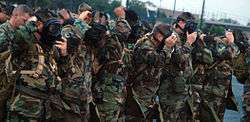
The first successful use of chemical agents by terrorists against a general civilian population was on June 27, 1994, when Aum Shinrikyo, an apocalyptic group based in Japan that believed it necessary to destroy the planet, released sarin gas in Matsumoto, Japan, killing eight and harming 200. The following year, Aum Shinrikyo released sarin into the Tokyo subway system killing 12 and injuring over 5,000.
On December 29, 1999, four days after Russian forces began an assault of Grozny, Chechen terrorists exploded two chlorine tanks in the town. Because of the wind conditions, no Russian soldiers were injured.[120]
Following the September 11, 2001 attacks on the U.S. cities of New York City and Washington, D.C., the organization Al-Qaeda responsible for the attacks announced that they were attempting to acquire radiological, biological, and chemical weapons. This threat was lent a great deal of credibility when a large archive of videotapes was obtained by the cable television network CNN in August 2002 showing, among other things, the killing of three dogs by an apparent nerve agent.[121]
In an anti-terrorist attack on October 26, 2002, Russian special forces used a chemical agent (presumably KOLOKOL-1, an aerosolized fentanyl derivative), as a precursor to an assault on Chechen terrorists, meant to incapacitate them with minimal harm to the hostages, ending the Moscow theater hostage crisis. All 42 of the terrorists and 120 out of 850 hostages were killed during the raid. Of the hostages who died, all but one or two died from the effects of the agent.
In early 2007, multiple terrorist bombings had been reported in Iraq using chlorine gas. These attacks wounded or sickened more than 350 people. Reportedly the bombers were affiliated with Al-Qaeda in Iraq,[122] and they have used bombs of various sizes up to chlorine tanker trucks.[123] United Nations Secretary-General Ban Ki-moon condemned the attacks as "clearly intended to cause panic and instability in the country."[124]
Chemical weapons treaties
The Protocol for the Prohibition of the Use in War of Asphyxiating, Poisonous or other Gases, and the Bacteriological Methods of Warfare, or the Geneva Protocol, is an international treaty which prohibits the use of chemical and biological weapons in warfare. Signed into international Law at Geneva on June 17, 1925 and entered into force on February 8, 1928, this treaty states that chemical and biological weapons are "justly condemned by the general opinion of the civilised world."[125]
Chemical Weapons Convention
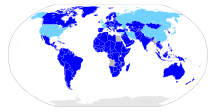
The most recent arms control agreement in International Law, the Convention of the Prohibition of the Development, Production, Stockpiling and Use of Chemical Weapons and on their Destruction, or the Chemical Weapons Convention, outlaws the production, stockpiling, and use of chemical weapons. It is administered by the Organisation for the Prohibition of Chemical Weapons (OPCW), an intergovernmental organisation based in The Hague.[126]
Technology
| Agents | Dissemination | Protection | Detection | |
|---|---|---|---|---|
| 1914 | Chlorine Chloropicrin Phosgene Mustard gas |
Wind dispersal | Gas masks, urinated-on gauze | Smell |
| 1918 | Lewisite | Chemical shells | Gas mask Rosin oil clothing |
smell of geraniums |
| 1920s | Projectiles w/ central bursters | CC-2 clothing | ||
| 1930s | G-series nerve agents | Aircraft bombs | Blister agent detectors Color change paper | |
| 1940s | Missile warheads Spray tanks |
Protective ointment (mustard) Collective protection Gas mask w/ Whetlerite |
||
| 1950s | ||||
| 1960s | V-series nerve agents | Aerodynamic | Gas mask w/ water supply | Nerve gas alarm |
| 1970s | ||||
| 1980s | Binary munitions | Improved gas masks (protection, fit, comfort) |
Laser detection | |
| 1990s | Novichok nerve agents |
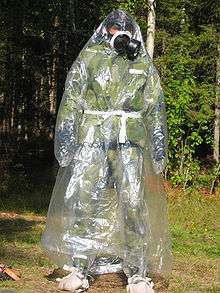
Although crude chemical warfare has been employed in many parts of the world for thousands of years,[127] "modern" chemical warfare began during World War I - see Chemical weapons in World War I.
Initially, only well-known commercially available chemicals and their variants were used. These included chlorine and phosgene gas. The methods used to disperse these agents during battle were relatively unrefined and inefficient. Even so, casualties could be heavy, due to the mainly static troop positions which were characteristic features of trench warfare.
Germany, the first side to employ chemical warfare on the battlefield,[128] simply opened canisters of chlorine upwind of the opposing side and let the prevailing winds do the dissemination. Soon after, the French modified artillery munitions to contain phosgene – a much more effective method that became the principal means of delivery.[129]
Since the development of modern chemical warfare in World War I, nations have pursued research and development on chemical weapons that falls into four major categories: new and more deadly agents; more efficient methods of delivering agents to the target (dissemination); more reliable means of defense against chemical weapons; and more sensitive and accurate means of detecting chemical agents.
Chemical warfare agents
A chemical used in warfare is called a chemical warfare agent (CWA). About 70 different chemicals have been used or stockpiled as chemical warfare agents during the 20th and 21st centuries. These agents may be in liquid, gas or solid form. Liquid agents that evaporate quickly are said to be volatile or have a high vapor pressure. Many chemical agents are made volatile so they can be dispersed over a large region quickly.
The earliest target of chemical warfare agent research was not toxicity, but development of agents that can affect a target through the skin and clothing, rendering protective gas masks useless. In July 1917, the Germans employed mustard gas. Mustard gas easily penetrates leather and fabric to inflict painful burns on the skin.
Chemical warfare agents are divided into lethal and incapacitating categories. A substance is classified as incapacitating if less than 1/100 of the lethal dose causes incapacitation, e.g., through nausea or visual problems. The distinction between lethal and incapacitating substances is not fixed, but relies on a statistical average called the LD50.
Persistency
Chemical warfare agents can be classified according to their persistency, a measure of the length of time that a chemical agent remains effective after dissemination. Chemical agents are classified as persistent or nonpersistent.
Agents classified as nonpersistent lose effectiveness after only a few minutes or hours or even only a few seconds. Purely gaseous agents such as chlorine are nonpersistent, as are highly volatile agents such as sarin. Tactically, nonpersistent agents are very useful against targets that are to be taken over and controlled very quickly.
Apart from the agent used, the delivery mode is very important. To achieve a nonpersistent deployment, the agent is dispersed into very small droplets comparable with the mist produced by an aerosol can. In this form not only the gaseous part of the agent (around 50%) but also the fine aerosol can be inhaled or absorbed through pores in the skin.
Modern doctrine requires very high concentrations almost instantly in order to be effective (one breath should contain a lethal dose of the agent). To achieve this, the primary weapons used would be rocket artillery or bombs and large ballistic missiles with cluster warheads. The contamination in the target area is only low or not existent and after four hours sarin or similar agents are not detectable anymore.
By contrast, persistent agents tend to remain in the environment for as long as several weeks, complicating decontamination. Defense against persistent agents requires shielding for extended periods of time. Non-volatile liquid agents, such as blister agents and the oily VX nerve agent, do not easily evaporate into a gas, and therefore present primarily a contact hazard.
The droplet size used for persistent delivery goes up to 1 mm increasing the falling speed and therefore about 80% of the deployed agent reaches the ground, resulting in heavy contamination. Deployment of persistent agents is intended to constrain enemy operations by denying access to contaminated areas.
Possible targets include enemy flank positions (averting possible counterattacks), artillery regiments, commando posts or supply lines. Because it is not necessary to deliver large quantities of the agent in a short period of time, a wide variety of weapons systems can be used.
A special form of persistent agents are thickened agents. These comprise a common agent mixed with thickeners to provide gelatinous, sticky agents. Primary targets for this kind of use include airfields, due to the increased persistency and difficulty of decontaminating affected areas.
Classes
Chemical weapons are inert agents that come in four categories: choking, blister, blood and nerve.[130] The agents are organized into several categories according to the manner in which they affect the human body. The names and number of categories varies slightly from source to source, but in general, types of chemical warfare agents are as follows:
| Class of agent | Agent Names | Mode of Action | Signs and Symptoms | Rate of action | Persistency |
|---|---|---|---|---|---|
| Nerve |
|
Inactivates enzyme acetylcholinesterase, preventing the breakdown of the neurotransmitter acetylcholine in the victim's synapses and causing both muscarinic and nicotinic effects |
|
VX is persistent and a contact hazard; other agents are non-persistent and present mostly inhalation hazards. | |
| Asphyxiant/Blood |
|
|
Immediate onset | Non-persistent and an inhalation hazard. | |
| Vesicant/Blister |
|
Agents are acid-forming compounds that damages skin and respiratory system, resulting burns and respiratory problems. |
|
|
Persistent and a contact hazard. |
| Choking/Pulmonary | Similar mechanism to blister agents in that the compounds are acids or acid-forming, but action is more pronounced in respiratory system, flooding it and resulting in suffocation; survivors often suffer chronic breathing problems. |
|
Immediate to 3 hours | Non-persistent and an inhalation hazard. | |
| Lachrymatory agent | Causes severe stinging of the eyes and temporary blindness. | Powerful eye irritation | Immediate | Non-persistent and an inhalation hazard. | |
| Incapacitating |
|
Causes atropine-like inhibition of acetylcholine in subject. Causes peripheral nervous system effects that are the opposite of those seen in nerve agent poisoning. |
|
|
Extremely persistent in soil and water and on most surfaces; contact hazard. |
| Cytotoxic proteins |
Non-living biological proteins, such as: |
Inhibit protein synthesis |
|
4-24 hours; see symptoms. Exposure by inhalation or injection causes more pronounced signs and symptoms than exposure by ingestion | Slight; agents degrade quickly in environment |
There are other chemicals used militarily that are not scheduled by the Chemical Weapons Convention, and thus are not controlled under the CWC treaties. These include:
- Defoliants and herbicides that destroy vegetation, but are not immediately toxic or poisonous to human beings. Their use is classified as herbicidal warfare. Some batches of Agent Orange, for instance, used by the British during the Malayan Emergency and the United States during the Vietnam War, contained dioxins as manufacturing impurities. Dioxins, rather than Agent Orange itself, have long-term cancer effects and for causing genetic damage leading to serious birth deformities.
- Incendiary or explosive chemicals (such as napalm, extensively used by the United States during the Korean War and the Vietnam War, or dynamite) because their destructive effects are primarily due to fire or explosive force, and not direct chemical action. Their use is classified as conventional warfare.
- Viruses, bacteria, or other organisms. Their use is classified as biological warfare. Toxins produced by living organisms are considered chemical weapons, although the boundary is blurry. Toxins are covered by the Biological Weapons Convention.
Designations
Most chemical weapons are assigned a one- to three-letter "NATO weapon designation" in addition to, or in place of, a common name. Binary munitions, in which precursors for chemical warfare agents are automatically mixed in shell to produce the agent just prior to its use, are indicated by a "-2" following the agent's designation (for example, GB-2 and VX-2).
Some examples are given below:
| Blood agents: | Vesicants: |
|---|---|
|
|
| Pulmonary agents: | Incapacitating agents: |
|
|
| Lachrymatory agents: | Nerve agents: |
|
Delivery
The most important factor in the effectiveness of chemical weapons is the efficiency of its delivery, or dissemination, to a target. The most common techniques include munitions (such as bombs, projectiles, warheads) that allow dissemination at a distance and spray tanks which disseminate from low-flying aircraft. Developments in the techniques of filling and storage of munitions have also been important.
Although there have been many advances in chemical weapon delivery since World War I, it is still difficult to achieve effective dispersion. The dissemination is highly dependent on atmospheric conditions because many chemical agents act in gaseous form. Thus, weather observations and forecasting are essential to optimize weapon delivery and reduce the risk of injuring friendly forces.
Dispersion
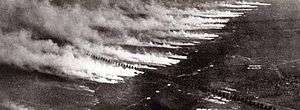
Dispersion is placing the chemical agent upon or adjacent to a target immediately before dissemination, so that the material is most efficiently used. Dispersion is the simplest technique of delivering an agent to its target. The most common techniques are munitions, bombs, projectiles, spray tanks and warheads.
World War I saw the earliest implementation of this technique. The actual first chemical ammunition was the French 26 mm cartouche suffocante rifle grenade, fired from a flare carbine. It contained 35g of the tear-producer ethyl bromoacetate, and was used in autumn 1914 – with little effect on the Germans.
The Germans on the other hand tried to increase the effect of 10.5 cm shrapnel shells by adding an irritant – dianisidine chlorosulfonate. Its use went unnoticed by the British when it was used against them at Neuve Chapelle in October 1914. Hans Tappen, a chemist in the Heavy Artillery Department of the War Ministry, suggested to his brother, the Chief of the Operations Branch at German General Headquarters, the use of the tear-gases benzyl bromide or xylyl bromide.
Shells were tested successfully at the Wahn artillery range near Cologne on January 9, 1915, and an order was placed for 15 cm howitzer shells, designated ‘T-shells’ after Tappen. A shortage of shells limited the first use against the Russians at Bolimów on January 31, 1915; the liquid failed to vaporize in the cold weather, and again the experiment went unnoticed by the Allies.
The first effective use were when the German forces at the Second Battle of Ypres simply opened cylinders of chlorine and allowed the wind to carry the gas across enemy lines. While simple, this technique had numerous disadvantages. Moving large numbers of heavy gas cylinders to the front-line positions from where the gas would be released was a lengthy and difficult logistical task.
Stockpiles of cylinders had to be stored at the front line, posing a great risk if hit by artillery shells. Gas delivery depended greatly on wind speed and direction. If the wind was fickle, as at Loos, the gas could blow back, causing friendly casualties.
Gas clouds gave plenty of warning, allowing the enemy time to protect themselves, though many soldiers found the sight of a creeping gas cloud unnerving. This made the gas doubly effective, as, in addition to damaging the enemy physically, it also had a psychological effect on the intended victims.
Another disadvantage was that gas clouds had limited penetration, capable only of affecting the front-line trenches before dissipating. Although it produced limited results in World War I, this technique shows how simple chemical weapon dissemination can be.
Shortly after this "open canister" dissemination, French forces developed a technique for delivery of phosgene in a non-explosive artillery shell. This technique overcame many of the risks of dealing with gas in cylinders. First, gas shells were independent of the wind and increased the effective range of gas, making any target within reach of guns vulnerable. Second, gas shells could be delivered without warning, especially the clear, nearly odorless phosgene– there are numerous accounts of gas shells, landing with a "plop" rather than exploding, being initially dismissed as dud high explosive or shrapnel shells, giving the gas time to work before the soldiers were alerted and took precautions.
The major drawback of artillery delivery was the difficulty of achieving a killing concentration. Each shell had a small gas payload and an area would have to be subjected to saturation bombardment to produce a cloud to match cylinder delivery. A British solution to the problem was the Livens Projector. This was effectively a large-bore mortar, dug into the ground that used the gas cylinders themselves as projectiles - firing a 14 kg cylinder up to 1500 m. This combined the gas volume of cylinders with the range of artillery.
Over the years, there were some refinements in this technique. In the 1950s and early 1960s, chemical artillery rockets and cluster bombs contained a multitude of submunitions, so that a large number of small clouds of the chemical agent would form directly on the target.
Thermal dissemination
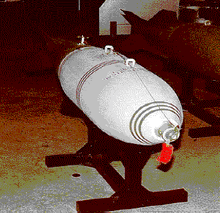
Thermal dissemination is the use of explosives or pyrotechnics to deliver chemical agents. This technique, developed in the 1920s, was a major improvement over earlier dispersal techniques, in that it allowed significant quantities of an agent to be disseminated over a considerable distance. Thermal dissemination remains the principal method of disseminating chemical agents today.
Most thermal dissemination devices consist of a bomb or projectile shell that contains a chemical agent and a central "burster" charge; when the burster detonates, the agent is expelled laterally.
Thermal dissemination devices, though common, are not particularly efficient. First, a percentage of the agent is lost by incineration in the initial blast and by being forced onto the ground. Second, the sizes of the particles vary greatly because explosive dissemination produces a mixture of liquid droplets of variable and difficult to control sizes.
The efficacy of thermal detonation is greatly limited by the flammability of some agents. For flammable aerosols, the cloud is sometimes totally or partially ignited by the disseminating explosion in a phenomenon called flashing. Explosively disseminated VX will ignite roughly one third of the time. Despite a great deal of study, flashing is still not fully understood, and a solution to the problem would be a major technological advance.
Despite the limitations of central bursters, most nations use this method in the early stages of chemical weapon development, in part because standard munitions can be adapted to carry the agents.

Aerodynamic dissemination
Aerodynamic dissemination is the non-explosive delivery of a chemical agent from an aircraft, allowing aerodynamic stress to disseminate the agent. This technique is the most recent major development in chemical agent dissemination, originating in the mid-1960s.
This technique eliminates many of the limitations of thermal dissemination by eliminating the flashing effect and theoretically allowing precise control of particle size. In actuality, the altitude of dissemination, wind direction and velocity, and the direction and velocity of the aircraft greatly influence particle size. There are other drawbacks as well; ideal deployment requires precise knowledge of aerodynamics and fluid dynamics, and because the agent must usually be dispersed within the boundary layer (less than 200–300 ft above the ground), it puts pilots at risk.
Significant research is still being applied toward this technique. For example, by modifying the properties of the liquid, its breakup when subjected to aerodynamic stress can be controlled and an idealized particle distribution achieved, even at supersonic speed. Additionally, advances in fluid dynamics, computer modeling, and weather forecasting allow an ideal direction, speed, and altitude to be calculated, such that warfare agent of a predetermined particle size can predictably and reliably hit a target.
Protection against chemical warfare

Ideal protection begins with nonproliferation treaties such as the Chemical Weapons Convention, and detecting, very early, the signatures of someone building a chemical weapons capability. These include a wide range of intelligence disciplines, such as economic analysis of exports of dual-use chemicals and equipment, human intelligence (HUMINT) such as diplomatic, refugee, and agent reports; photography from satellites, aircraft and drones (IMINT); examination of captured equipment (TECHINT); communications intercepts (COMINT); and detection of chemical manufacturing and chemical agents themselves (MASINT).
If all the preventive measures fail and there is a clear and present danger, then there is a need for detection of chemical attacks,[131] collective protection,[132][133][134] and decontamination. Since industrial accidents can cause dangerous chemical releases (e.g., the Bhopal disaster), these activities are things that civilian, as well as military, organizations must be prepared to carry out. In civilian situations in developed countries, these are duties of HAZMAT organizations, which most commonly are part of fire departments.
Detection has been referred to above, as a technical MASINT discipline; specific military procedures, which are usually the model for civilian procedures, depend on the equipment, expertise, and personnel available. When chemical agents are detected, an alarm needs to sound, with specific warnings over emergency broadcasts and the like. There may be a warning to expect an attack.
If, for example, the captain of a US Navy ship believes there is a serious threat of chemical, biological, or radiological attack, the crew may be ordered to set Circle William, which means closing all openings to outside air, running breathing air through filters, and possibly starting a system that continually washes down the exterior surfaces. Civilian authorities dealing with an attack or a toxic chemical accident will invoke the Incident Command System, or local equivalent, to coordinate defensive measures.[134]
Individual protection starts with a gas mask and, depending on the nature of the threat, through various levels of protective clothing up to a complete chemical-resistant suit with a self-contained air supply. The US military defines various levels of MOPP (mission-oriented protective posture) from mask to full chemical resistant suits; Hazmat suits are the civilian equivalent, but go farther to include a fully independent air supply, rather than the filters of a gas mask.
Collective protection allows continued functioning of groups of people in buildings or shelters, the latter which may be fixed, mobile, or improvised. With ordinary buildings, this may be as basic as plastic sheeting and tape, although if the protection needs to be continued for any appreciable length of time, there will need to be an air supply, typically an enhanced gas mask.[133][134]
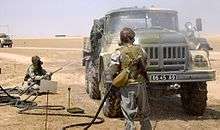
Decontamination
Decontamination varies with the particular chemical agent used. Some nonpersistent agents, including most pulmonary agents (chlorine, phosgene, and so on), blood gases, and nonpersistent nerve gases (e.g., GB), will dissipate from open areas, although powerful exhaust fans may be needed to clear out buildings where they have accumulated.
In some cases, it might be necessary to neutralize them chemically, as with ammonia as a neutralizer for hydrogen cyanide or chlorine. Riot control agents such as CS will dissipate in an open area, but things contaminated with CS powder need to be aired out, washed by people wearing protective gear, or safely discarded.
Mass decontamination is a less common requirement for people than equipment, since people may be immediately affected and treatment is the action required. It is a requirement when people have been contaminated with persistent agents. Treatment and decontamination may need to be simultaneous, with the medical personnel protecting themselves so they can function.[135]
There may need to be immediate intervention to prevent death, such as injection of atropine for nerve agents. Decontamination is especially important for people contaminated with persistent agents; many of the fatalities after the explosion of a WWII US ammunition ship carrying mustard gas, in the harbor of Bari, Italy, after a German bombing on December 2, 1943, came when rescue workers, not knowing of the contamination, bundled cold, wet seamen in tight-fitting blankets.
For decontaminating equipment and buildings exposed to persistent agents, such as blister agents, VX or other agents made persistent by mixing with a thickener, special equipment and materials might be needed. Some type of neutralizing agent will be needed; e.g. in the form of a spraying device with neutralizing agents such as Chlorine, Fichlor, strong alkaline solutions or enzymes. In other cases, a specific chemical decontaminant will be required.[134]
Sociopolitical climate
The study of chemicals and their military uses was widespread in China and India. The use of toxic materials has historically been viewed with mixed emotions and moral qualms in the West. The practical and ethical problems surrounding poison warfare appeared in ancient Greek myths about Hercules' invention of poison arrows and Odysseus's use of toxic projectiles. There are many instances of the use of chemical weapons in battles documented in Greek and Roman historical texts; the earliest example was the deliberate poisoning of Kirrha's water supply with hellebore in the First Sacred War, Greece, about 590 BC.[136]
One of the earliest reactions to the use of chemical agents was from Rome. Struggling to defend themselves from the Roman legions, Germanic tribes poisoned the wells of their enemies, with Roman jurists having been recorded as declaring "armis bella non venenis geri", meaning "war is fought with weapons, not with poisons." Yet the Romans themselves resorted to poisoning wells of besieged cities in Anatolia in the 2nd century BCE.[4]
Before 1915 the use of poisonous chemicals in battle was typically the result of local initiative, and not the result of an active government chemical weapons program. There are many reports of the isolated use of chemical agents in individual battles or sieges, but there was no true tradition of their use outside of incendiaries and smoke. Despite this tendency, there have been several attempts to initiate large-scale implementation of poison gas in several wars, but with the notable exception of World War I, the responsible authorities generally rejected the proposals for ethical reasons.
For example, in 1854 Lyon Playfair (later 1st Baron Playfair, GCB, PC, FRS (May 1, 1818 – May 29, 1898), a British chemist, proposed using a cacodyl cyanide-filled artillery shell against enemy ships during the Crimean War. The British Ordnance Department rejected the proposal as "as bad a mode of warfare as poisoning the wells of the enemy."
Efforts to eradicate chemical weapons
| Countries with known or possible chemical weapons, as of 2013 | |||
|---|---|---|---|
| Nation | CW Possession | Signed CWC | Ratified CWC |
| Albania | Known | January 14, 1993[137] | May 11, 1994[137] |
| Burma (Myanmar) | Possible | January 14, 1993[138] | July 8, 2015[139] |
| China | Probable | January 13, 1993 | April 4, 1997 |
| Egypt | Probable | No | No |
| India | Known | January 14, 1993 | September 3, 1996 |
| Iran | Known | January 13, 1993 | November 3, 1997 |
| Israel | Probable | January 13, 1993[138] | No |
| Japan | Probable | January 13, 1993 | September 15, 1995 |
| Libya | Known | No | January 6, 2004 (acceded) |
| North Korea | Known | No | No |
| Pakistan | Probable | January 13, 1993 | October 28, 1997 |
| Russia | Known | January 13, 1993 | November 5, 1997 |
| Serbia and Montenegro |
Probable | No | April 20, 2000 (acceded) |
| Sudan | Possible | No | May 24, 1999 (acceded) |
| Syria | Known | No | September 14, 2013 (acceded) |
| Taiwan | Possible | n/a | n/a |
| United States | Known | January 13, 1993 | April 25, 1997 |
| Vietnam | Probable | January 13, 1993 | September 30, 1998 |
- August 27, 1874: The Brussels Declaration Concerning the Laws and Customs of War is signed, specifically forbidding the "employment of poison or poisoned weapons", although the treaty was not adopted by any nation whatsoever and it never went into effect.
- September 4, 1900: The First Hague Convention, which includes a declaration banning the "use of projectiles the object of which is the diffusion of asphyxiating or deleterious gases," enters into force.
- January 26, 1910: The Second Hague Convention enters into force, prohibiting the use of "poison or poisoned weapons" in warfare.
- February 6, 1922: After World War I, the Washington Arms Conference Treaty prohibited the use of asphyxiating, poisonous or other gases. It was signed by the United States, Britain, Japan, France, and Italy, but France objected to other provisions in the treaty and it never went into effect.
- February 8, 1928: The Geneva Protocol enters into force, prohibiting the use of "asphyxiating, poisonous or other gases, and of all analogous liquids, materials or devices" and "bacteriological methods of warfare".
Chemical weapon proliferation
Despite numerous efforts to reduce or eliminate them, some nations continue to research and/or stockpile chemical warfare agents. To the right is a summary of the nations that have either declared weapon stockpiles or are suspected of secretly stockpiling or possessing CW research programs. Notable examples include United States and Russia.
In 1997, future US Vice President Dick Cheney opposed the signing ratification of a treaty banning the use chemical weapons, a recently unearthed letter shows. In a letter dated April 8, 1997, then Halliburton-CEO Cheney told Sen. Jesse Helms, the chairman of the Senate Foreign Relations Committee, that it would be a mistake for America to join the Convention. "Those nations most likely to comply with the Chemical Weapons Convention are not likely to ever constitute a military threat to the United States. The governments we should be concerned about are likely to cheat on the CWC, even if they do participate," reads the letter,[140] published by the Federation of American Scientists.
The CWC was ratified by the Senate that same month. Since then, Albania, Libya, Russia, the United States, and India have declared over 71,000 metric tons of chemical weapon stockpiles, and destroyed about a third of them. Under the terms of the agreement, the United States and Russia agreed to eliminate the rest of their supplies of chemical weapons by 2012. Not having met its goal, the U.S. government estimates remaining stocks will be destroyed by 2017.
Chemical weapons destruction
India
In June 1997, India declared that it had a stockpile of 1044 tons of sulphur mustard in its possession. India's declaration of its stockpile came after its entry into the Chemical Weapons Convention, that created the Organisation for the Prohibition of Chemical Weapons, and on January 14, 1993 India became one of the original signatories to the Chemical Weapons Convention. By 2005, from among six nations that had declared their possession of chemical weapons, India was the only country to meet its deadline for chemical weapons destruction and for inspection of its facilities by the Organisation for the Prohibition of Chemical Weapons.[141][142] By 2006, India had destroyed more than 75 percent of its chemical weapons and material stockpile and was granted an extension to complete a 100 percent destruction of its stocks by April 2009. On May 14, 2009 India informed the United Nations that it has completely destroyed its stockpile of chemical weapons.[143]
Iraq
The Director-General of the Organisation for the Prohibition of Chemical Weapons, Ambassador Rogelio Pfirter, welcomed Iraq's decision to join the OPCW as a significant step to strengthening global and regional efforts to prevent the spread and use of chemical weapons. The OPCW announced "The government of Iraq has deposited its instrument of accession to the Chemical Weapons Convention with the Secretary General of the United Nations and within 30 days, on 12 February 2009, will become the 186th State Party to the Convention". Iraq has also declared stockpiles of chemical weapons, and because of their recent accession is the only State Party exempted from the destruction time-line.[144]
Japan
During the Second Sino-Japanese War (1937–1945) Japan stored chemical weapons on the territory of mainland China. The weapon stock mostly containing mustard gas-lewisite mixture.[145] The weapons are classified as abandoned chemical weapons under the Chemical Weapons Convention and from September 2010 Japan has started their destruction in Nanjing using mobile destruction facilities in order to do so.[146]
Russia
Russia signed into the Chemical Weapons Convention on January 13, 1993 and ratified it on November 5, 1995. Declaring an arsenal of 39,967 tons of chemical weapons in 1997, by far the largest arsenal, consisting of blister agents: Lewisite, Sulfur mustard, Lewisite-mustard mix, and nerve agents: Sarin, Soman, and VX. Russia met its treaty obligations by destroying 1 percent of its chemical agents by the 2002 deadline set out by the Chemical Weapons Convention, but requested an extension on the deadlines of 2004 and 2007 due to technical, financial, and environmental challenges of chemical disposal. Since, Russia has received help from other countries such as Canada which donated C$100,000, plus a further C$100,000 already donated, to the Russian Chemical Weapons Destruction Program. This money will be used to complete work at Shchuch'ye and support the construction of a chemical weapons destruction facility at Kizner (Russia), where the destruction of nearly 5,700 tons of nerve agent, stored in approximately 2 million artillery shells and munitions, will be undertaken. Canadian funds are also being used for the operation of a Green Cross Public Outreach Office, to keep the civilian population informed on the progress made in chemical weapons destruction activities.[147]
As of July 2011, Russia has destroyed 48 percent (18,241 tons) of its stockpile at destruction facilities located in Gorny (Saratov Oblast) and Kambarka (Udmurt Republic) - where operations have finished - and Schuch'ye (Kurgan Oblast), Maradykovsky (Kirov Oblast), Leonidovka (Penza Oblast) whilst installations are under construction in Pochep (Bryansk Oblast) and Kizner (Udmurt Republic).[148] As August 2013, 76 percent (30,500 tons) were destroyed,[149] and Russia leaves the Cooperative Threat Reduction (CTR) Program, which partially funded chemical weapons destruction.[150]
United States
On November 25, 1969, President Richard Nixon unilaterally renounced the use of chemical weapons and renounced all methods of biological warfare. He issued a decree halting the production and transport of all chemical weapons which remains in effect. From May 1964 to the early 1970s the USA participated in Operation CHASE, a United States Department of Defense program that aimed to dispose of chemical weapons by sinking ships laden with the weapons in the deep Atlantic. After the Marine Protection, Research, and Sanctuaries Act of 1972, Operation Chase was scrapped and safer disposal methods for chemical weapons were researched, with the U.S. destroying several thousand tons of mustard gas by incineration at the Rocky Mountain Arsenal, and nearly 4,200 tons of nerve agent by chemical neutralisation at Tooele Army Depot.[151]
The U.S. ratified the Geneva Protocol which banned the use of chemical and biological weapons on January 22, 1975. In 1989 and 1990, the U.S. and the Soviet Union entered an agreement to both end their chemical weapons programs, including binary weapons. In April 1997, the United States ratified the Chemical Weapons Convention, this banned the possession of most types of chemical weapons. It also banned the development of chemical weapons, and required the destruction of existing stockpiles, precursor chemicals, production facilities, and their weapon delivery systems.
The U.S. began stockpile reductions in the 1980s with the removal of outdated munitions and destroying its entire stock of 3-Quinuclidinyl benzilate (BZ or Agent 15) at the beginning of 1988. In June 1990 the Johnston Atoll Chemical Agent Disposal System began destruction of chemical agents stored on the Johnston Atoll in the Pacific, seven years before the Chemical Weapons Treaty came into effect. In 1986 President Ronald Reagan made an agreement with the Chancellor, Helmut Kohl to remove the U.S. stockpile of chemical weapons from Germany. In 1990, as part of Operation Steel Box, two ships were loaded with over 100,000 shells containing Sarin and VX were taken from the U.S. Army weapons storage depots such as Miesau and then-classified FSTS (Forward Storage / Transportation Sites) and transported from Bremerhaven, Germany to Johnston Atoll in the Pacific, a 46-day nonstop journey.[152]
In May 1991, President George H. W. Bush committed the United States to destroying all of its chemical weapons and renounced the right to chemical weapon retaliation. In 1993, the United States signed the Chemical Weapons Treaty, which required the destruction of all chemical weapon agents, dispersal systems, and production facilities by April 2012. The U.S. prohibition on the transport of chemical weapons has meant that destruction facilities had to be constructed at each of the U.S.'s nine storage facilities. The U.S. met the first three of the four deadlines set out in the treaty, destroying 45% of its stockpile of chemical weapons by 2007. Due to the destruction of chemical weapons, under the United States policy of Proportional Response, an attack upon the United States or its Allies would trigger a force-equivalent counter-attack. Since the United States only maintains nuclear Weapons of Mass Destruction, it is the stated policy that the United States will regard all WMD attacks (Biological, chemical, or nuclear) as a nuclear attack and will respond to such an attack with a nuclear strike.[153]
As of 2012, stockpiles have been eliminated at 7 of the 9 chemical weapons depots and 89.75% of the 1997 stockpile has been destroyed by the treaty deadline of April 2012.[154] Destruction will not begin at the two remaining depots until after the treaty deadline and will use neutralization, instead of incineration.
Herbicidal warfare
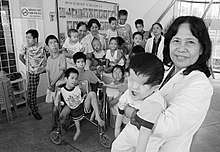
Although herbicidal warfare use chemical substances, its main purpose is to disrupt agricultural food production and/or to destroy plants which provide cover or concealment to the enemy.
The use of herbicides as a chemical weapon by the U.S. military during the Vietnam War has left tangible, long-term impacts upon the Vietnamese people that live in Vietnam.[155][156] For instance, it led to 3 million Vietnamese people suffering health problems, one million birth defects caused directly by exposure to Agent Orange, and 24% of the area of Vietnam being defoliated.[157]
See also
- 1990 Chemical Weapons Accord
- Agent Orange
- Ali Hassan al-Majid
- Area denial weapon
- Biological warfare
- Chemical Weapons Convention
- Chemical weapon designation
- Chemical weapons and the United Kingdom
- Gas chamber
- Lethal Unitary Chemical Agents and Munitions
- List of chemical warfare agents
- List of highly toxic gases
- Ronald Maddison
- Psychochemical weapon
- Saint Julien Memorial
- Sardasht (A town attacked with chemical weapons during the Iran–Iraq War.)
- Stink bomb
- United States Army Medical Research Institute of Chemical Defense
- Weapon of mass destruction
- Zyklon B
Notes
- ↑ Rule 74. The use of chemical weapons is prohibited., Customary IHL Database, International Committee of the Red Cross (ICRC)/Cambridge University Press.
- ↑ "Convention on the Prohibition of the Development, Production, Stockpiling and Use of Chemical Weapons and on Their Destruction (CWC): Annexes and Original Signatories". Bureau of Arms Control, Verification and Compliance. Retrieved January 19, 2012.
- ↑ Disarmament lessons from the Chemical Weapons Convention Archived June 6, 2013, at the Wayback Machine.
- 1 2 3 4 Mayor 2003
- ↑ Michael Bothe; Natalino Ronzitti; Allan Rosas, eds. (1998), The New Chemical Weapons Convention - Implementation and Prospects, Martinus Nijhoff Publishers, p. 17, ISBN 90-411-1099-2
- 1 2 Richardt, Andre (2013), CBRN Protection: Managing the Threat of Chemical, Biological, Radioactive and Nuclear Weapons, Germany: Wiley-VCH Verlag & Co., p. 4, ISBN 978-3-527-32413-2
- ↑ Science Daily, dated January 19, 2009 Sciencedaily.com
- ↑ “Death Underground: Gas Warfare at Dura-Europos,” Current Archaeology, November 26, 2009 (online feature) http://www.archaeology.co.uk/cwa/world-news/death-underground-gas-warfare-at-dura-europos.htm (accessed October 3, 2014)
- ↑ Samir S. Patel, “Early Chemical Warfare – Dura-Europos, Syria,” Archaeology, Vol. 63, No. 1, January/February 2010, http://www.archaeology.org/1001/topten/syria.html (accessed October 3, 2014)
- ↑ Stephanie Pappas, “Buried Soldiers May Be Victims of Ancient Chemical Weapon,” LiveScience, March 8, 2011, http://www.livescience.com/13113-ancient-chemical-warfare-romans-persians.html (accessed October 3, 2014).
- ↑ Sayers W. The Use of Quicklime in Medieval Naval Warfare // The Mariner's Mirror. - Volume 92 (2006). - Issue 3. - PP. 262-269.
- ↑ David Hume, History of England, Volume II.
- ↑ Charles C. Mann (2011), 1493: Uncovering the New World Columbus Created, Random House Digital, p. 9, ISBN 978-0-307-59672-7
- ↑ Eric Croddy (2002). Chemical and Biological Warfare: A Comprehensive Survey for the Concerned Citizen. Springer. p. 131.
- ↑ Smart, Jeffery K. "CHEMICAL AND BIOLOGICAL WARFARE RESEARCH AND DEVELOPMENT DURING THE CIVIL WAR" (PDF). United States Army. US Army Soldier and Biological Chemical Command. Retrieved November 7, 2014.
- ↑ Verwey, Wil D. (1977). Riot control agents and herbicides in war : their humanitarian, toxicological, ecological, military, palemological, and legal aspects. Lieden: Sigthoff. pp. 33–34, 196. ISBN 9789028603363. Retrieved April 13, 2017.
- ↑ "The First World War" (a Channel 4 documentary based on the book by Hew Strachan)
- ↑ Faith, Thomas (2014). Behind the gas mask : the U.S. chemical warfare service in war and peace. Champaign, IL: University of Illinois Press. p. 9. ISBN 978-0252080265. Retrieved April 14, 2017.
- ↑ "April 22, 1915: Germans introduce poison gas". This Day In History. Retrieved April 14, 2017.
- 1 2 Gross, Daniel A. (Spring 2015). "Chemical Warfare: From the European Battlefield to the American Laboratory". Distillations. 1 (1): 16–23. Retrieved March 20, 2018.
- ↑ D. Hank Ellison (August 24, 2007). Handbook of Chemical and Biological Warfare Agents, Second Edition. CRC Press. pp. 567–570. ISBN 0-8493-1434-8.
- ↑ Max Boot (August 16, 2007). War Made New: Weapons, Warriors, and the Making of the Modern World. Gotham. pp. 245–250. ISBN 1-5924-0315-8.
- ↑ Colditz, Graham A. (2007). Encyclopedia of cancer and society. Los Angeles: Sage Publications. pp. 1013–1015. ISBN 978-1412949897. Retrieved April 14, 2017.
- ↑ Albright, Richard D. (2012). Cleanup of chemical and explosive munitions : locating, identifying contaminants, and planning for environmental remediation of land and sea military ranges and ordnance dumpsites (2nd ed.). Amsterdam: Elsevier/William Andrew. pp. 137–240. ISBN 978-1-4377-3477-5. Retrieved April 13, 2017.
- ↑ Ashooh, Emma (December 7, 2015). "A Hidden History: American University's Role in World War I". American Word. Retrieved April 13, 2017.
- 1 2 Curry, Andrew (November 10, 2016). "Weapons of War Litter the Ocean Floor". Hakai Magazine. Retrieved April 14, 2017.
- ↑ Tyner, James A. (2010). Military legacies : a world made by war. New York (N.Y.): Routledge. pp. 113–115. ISBN 978-0415995948. Retrieved April 14, 2017.
- ↑ Andrulewicz, E. (2007). "Chemical weapons dumped in the Baltic Sea". In Gonenc, I.E.; Koutitonsky, V.G.; Rashleigh, B.; Ambrose, R.B.; Wolflin, J.P. Assessment of the Fate and Effects of Toxic Agents on Water Resources (NATO Security through Science Series ed.). Dordrecht: Springer.
- ↑ HELCOM (1994). Report on Chemical Munitions Dumped in the Baltic Sea Report to the 16th Meeting of Helsinki Commission 8 - 11 March 1994 from the Ad Hoc Working Group on Dumped Chemical Munition (HELCOM CHEMU) January 1994 (PDF). Danish Environmental Protection Agency.
- ↑ Edvard Radzinsky (2011). Stalin. Knopf Doubleday. p. 173.
- ↑ Nicolas Werth, Karel Bartošek, Jean-Louis Panné, Jean-Louis Margolin, Andrzej Paczkowski, Stéphane Courtois, The Black Book of Communism: Crimes, Terror, Repression, Harvard University Press, 1999, hardcover, 858 pages, ISBN 0-674-07608-7
- 1 2 Ronald Bruce St John, Libya: Continuity and Change (Routledge, 2015), p. 16.
- ↑ Saskia van Genugten, Libya in Western Foreign Policies, 1911–2011 (Palgrave Macmillan, 2016), p. 31.
- ↑ Andrew Jackson Waskey & Spencer C. Tucker, "Senussi and Sultan of Darfur Rebellions" in Encyclopedia of Insurgency and Counterinsurgency: A New Era of Modern Warfare (ed. Spencer C. Tucker: ABC-CLIO, 2013), p. 498.
- 1 2 3 4 5 6 "Chemical Weapons" in Historical Dictionary of Ethiopia, 2d ed. (eds. David H. Shinn & Thomas P. Ofcansky: Scarecrow Press, 2013).
- 1 2 3 Rainer Baudendistel, Between Bombs and Good Intentions: The International Committee of the Red Cross and the Italo-Ethiopian War, 1935-1936, pp. 264-67.
- ↑ William R. Cullen, Is Arsenic an Aphrodisiac?: The Sociochemistry of an Element (Royal Society of Chemistry, 2008), p. 241.
- 1 2 3 4 Jeffrey Legro, Cooperation Under Fire: Anglo-German Restraint During World War II (Cornell University Press, 2005).
- ↑ Walter Laqueur, The New Terrorism: Fanaticism and the Arms of Mass Destruction (Oxford University Press, 1999), p. 57.
- ↑ Edward M. Spiers, Chemical and Biological Weapons: A Study of Proliferation (Macmillan: 1994).
- ↑ "Introduction" in Italian Colonialism (eds. Ruth Ben-Ghiat & Mia Fuller: Palgrave Macmillan, 2005), p. 6.
- ↑ Corum, James S., The Roots of Blitzkrieg, University Press of Kansas, USA, 1992, pp.106-107.
- ↑ Schmaltz, Florian (2005), Kampfstoff-Forschung im Nationalsozialismus Zur Kooperation von Kaiser-Wilhelm-Instituten, Militär und Industrie, Wallstein Verlag
- ↑ Schmaltz, Florian (2006), "Neurosciences and Research on Chemical Weapons of Mass Destruction in Nazi Germany", Journal of the History of the Neurosciences, 15 (3): 186–209, doi:10.1080/09647040600658229, PMID 16887760
- ↑ "Laws of War: Declaration on the Use of Projectiles the Object of Which is the Diffusion of Asphyxiating or Deleterious Gases; July 29, 1899". Avalon.law.yale.edu. Retrieved January 18, 2014.
- ↑ "Convention (IV) respecting the Laws and Customs of War on Land and its annex: Regulations concerning the Laws and Customs of War on Land. The Hague, 18 October 1907". International Committee of the Red Cross. Retrieved January 18, 2014.
- ↑ Yuki Tanaka, Poison Gas, the Story Japan Would Like to Forget, Bulletin of the Atomic Scientists, October 1988, p. 16-17
- ↑ Y. Yoshimi and S. Matsuno, Dokugasusen Kankei Shiryô II, Kaisetsu, Jugonen Sensô Gokuhi Shiryoshu, 1997, p.27-29
- ↑ Yoshimi and Matsuno, idem, Herbert Bix, Hirohito and the Making of Modern Japan, 2001, p.360-364
- ↑ Army History Unit, Chemical Warfare in Australia (2nd Edn) 2013 (Army Military History Series)
- ↑ Geoff Plunkett, Chemical Warfare in Australia
- ↑ Geoff Plunkett, Death By Mustard Gas
- 1 2 3 4 5 6 7 Patrick Coffey, American Arsenal: A Century of Weapon Technology and Strategy (Oxford University Press, 2014), p. 152-54.
- 1 2 James J. Wirtz, "Weapons of Mass Destruction" in Contemporary Security Studies (4th ed.), ed. Alan Collins, Contemporary Security Studies (Oxford University Press, 2016), p. 302.
- 1 2 Callum Borchers, Sean Spicer takes his questionable claims to a new level in Hitler-Assad comparison, The Washington Post (April 11, 2017).
- ↑ Germany and the Second World War, Vol. 5, Issue 2 (Clarendon Press, 2003), p. 764.
- ↑ "Century of biological and chemical weapons". BBC News. September 25, 2001.
- ↑ Stanley P. Lovell, Of Spies & Strategems (Englewood Cliffs, New Jersey: Prentice-Hall, 1963), p. 78.
- 1 2 Chris Bellamy, Absolute War: Soviet Russia in the Second World War (Knopf, 2008).
- 1 2 Israelyan, Victor. On the Battlefields of the Cold War: A Soviet Ambassador's Confession. p. 339.
- ↑ Merridale, Catherine, Ivan's War, Faber & Faber: pp. 148-150.
- 1 2 Гречко, p. 468.
- 1 2 Bellamy, Christopher (June 4, 1996). "Sixty secret mustard gas sites uncovered". The Independent.
- ↑ "Chemical Warfare -Suffolk". Anti-Invasion defences Suffolk World War II. Retrieved June 18, 2008.
- 1 2 Pears, Brian. "Chapter 5 Invasion". Rowlands Gill and the North-East 1939 - 1945. Archived from the original on August 6, 2006.
- ↑ Alanbrooke, 2001. Entry July 22, 1940.
- ↑ BBC2 Newsnight, 1/5/81; The Guardian, 7,9,13,20,30/5, 2/6/81; The Times, 11/5/81, 20/5/81, 15/6/81; The Listener, 25/6, 2/7, 17/8/81; Daily Telegraph, 18,21,25,29/5, 2,11/6/81; Encounter magazine, Vol.58-9 no.2; New Society, Vol.60; Bulletin of the Atomic Scientists, Vol.4 no.4 and 'Churchill's Anthrax Bombs - a debate', Vol.4 no.12, November 1987.
- ↑ Paxman, Jeremy; Harris, Robert (August 6, 2002) [1982]. "The War That Never Was". A higher form of killing: the secret history of chemical and biological warfare. p. 128. ISBN 978-0-8129-6653-4. OCLC 268949025.
I want the matter studied in cold blood by sensible people
- ↑ "Paxman and Harris", p132-35.
- 1 2 3 Smart, Jeffrey (1997), "2", History of Chemical and Biological Warfare: An American Perspective, Aberdeen, MD, USA: Army Chemical and Biological Defense Command, p. 32 .
- ↑ https://www.cdc.gov/niosh/ershdb/EmergencyResponseCard_29750039.html
- ↑ "Characteristics and Employment of Ground Chemical Munitions", Field Manual 3-5, Washington, DC: War Department, 1946, pp. 108–19 .
- ↑ Skates, John R (2000), The Invasion of Japan: Alternative to the Bomb, University of South Carolina Press, pp. 93–96, ISBN 978-1-57003-354-4
- ↑ US Naval Historical Center, Naval Armed Guard Service: Tragedy at Bari, Italy on 2 December 1943, archived from the original on January 12, 2008
- ↑ Niderost, Eric, World War II: German Raid on Bari (Full text), HistoryNet.com
- ↑ Infield, Glenn B. Infield, Disaster at Bari
- ↑ Reminick, Gerald, Nightmare in Bari: The World War II Liberty Ship Poison Gas Disaster and Coverup
- ↑ Ghosh, R.; Newman, J.E. (Jan 29, 1955). "A new group of organophosphorus pesticides". Chemistry and Industry: 118.
- ↑ G B Carter. Porton Down: a brief history.
- ↑ G B Carter (2000). Chemical and Biological Defence at Porton Down 1916–2000. The Stationery Office.
- ↑ Robert Bud; Philip Gummett (2002). Cold War, Hot Science: Applied Research in Britain's Defence Laboratories, 1945-1990. Science museum.
- 1 2 "Nancekuke Remediation Project". Ministry of Defence (Archived by The National Archives). Archived from the original on December 8, 2010. Retrieved April 25, 2012.
- ↑ Staff, Committee on Veterans' Affairs, US Senate (December 8, 1994), Is Military Research Hazardous to Veterans' Health? Lessons spanning half a century, 103d Congress, 2d Session - Committee Print - S. Prt. 103-97
- 1 2 Philip Huang (October 17, 2002), "Sickening strategy", Oregon Daily Emerald
- ↑ The Story of Genocide in Afghanistan Hassan Kakar
- ↑ Report from Afghanistan Claude Malhuret
- ↑ Yevgenia Albats and Catherine A. Fitzpatrick. The State Within a State: The KGB and Its Hold on Russia - Past, Present, and Future, 1994. ISBN 0-374-18104-7 (see pages 325–328)
- ↑ Fedorov, Lev (July 27, 1994), Chemical Weapons in Russia: History, Ecology, Politics, Center of Ecological Policy of Russia
- ↑ Birstein, Vadim J. (2004), The Perversion Of Knowledge: The True Story of Soviet Science, Westview Press, ISBN 0-8133-4280-5
- ↑ Federov, Lev; Mirzayanov, Vil (1992), "A Poisoned Policy", Moscow News (weekly No. 39)
- ↑ Cross, Glenn (2017), Dirty War: Rhodesia and Chemical Biological Warfare, 1975-1980, Helion & Company, ISBN 978-1-911512-12-7
- ↑ "KPNLF says Vietnamese Using Suffocant Gas," Bangkok World, January 4, 1985, p. 1.
- ↑ "Viets Accused of Using Gas Against Rebels," Associated Press, February 19, 1985.
- ↑ "Thais Report a Clash with Vietnamese Troops," Associated Press, February 20, 1985.
- ↑ Lafayette, Lev (July 26, 2002), "Who armed Saddam?", World History Archives
- ↑ Fassihi, Farnaz (October 27, 2002), "In Iran, grim reminders of Saddam's arsenal", New Jersey Star Ledger
- ↑ Paul Hughes (January 21, 2003), "It's like a knife stabbing into me", The Star (South Africa)
- ↑ Sciolino, Elaine (February 13, 2003), "Iraq Chemical Arms Condemned, but West Once Looked the Other Way", The New York Times, archived from the original on May 27, 2013
- 1 2 3 4 On this day: 1988: Thousands die in Halabja gas attack, BBC News (March 16, 1988).
- 1 2 3 4 Jonathan B. Tucker, Evidence Iraq Used Chemical Weapons During the 1991 Persian Gulf War, The Nonproliferation Review (Spring-Summer 1997), pp. 114-22.
- ↑ Israeli Responses to the Threat of Chemical Warfare, Prof. Gerald Steinberg, Published in Armed Forces and Society, Vol. 20., No. 1 Fall 1993, pp.85-101 (Faculty of Chemistry, Bar Ilan University website)
- ↑ The Gulf War, Netanel Lorch (published on the Israel ministry of foreign affairs website)
- ↑ The distribution of special gas masks for bearded men in footnote 19 about Prof. Yosseph Shilhav's research. Sticking Together page 139, Yakov Kop and Robert E. Litan (Google Books)
- ↑ Saddam gave orders to fire chemical weapons at Tel-Aviv if he was toppled in first gulf war January 25, 2014 (Times of Israel website)
- ↑ Chivers, C.J.; Schmitt, Eric (February 15, 2015). "CIA is said to have bought and destroyed Iraqi chemical weapons". The New York Times. Retrieved May 21, 2016.
- ↑ The chief U.N. weapons inspector said on Monday that Iraq could not account for stocks of anthrax and a deadly nerve gas that it said it had destroyed January 27, 2003, Cnn
- ↑ Deadly arsenals Joseph Cirincione et al. Page 343 quoting UNSCOM reports. (Google Books)
- 1 2 3 Hawk, Kathleen Dupes; Villella, Ron; Varona, Adolfo Leyva de (July 30, 2014). Florida and the Mariel Boatlift of 1980: The First Twenty Days. University of Alabama Press. ISBN 978-0817318376. Retrieved October 11, 2014.
- ↑ "Chemical weapons being used in Angola?". Park City Daily News. Bowling Green, Kentucky. August 22, 1986. Retrieved July 28, 2015.
- 1 2 3 Helen E. Purkitt, Stephen F. Burgess: The Rollback of South Africa's Chemical and Biological Warfare Program, Air University, Counterproliferation Center, Maxwell Airforce Base, Alabama, 2001
- ↑ "Cubans using poison gas in Angola". The Lewiston Journal. Lewiston–Auburn, Maine. August 26, 1988. Retrieved July 28, 2015.
- 1 2 Tokarev, Andrei; Shubin, Gennady, eds. (2011). Bush War: The Road to Cuito Cuanavale: Soviet Soldiers' Accounts of the Angolan War. Auckland Park: Jacana Media (Pty) Ltd. pp. 128–130. ISBN 978-1-4314-0185-7.
- ↑ The Argentine Fight for The Falklands, Lieutenant-Commander Sanchez-Sabarots
- ↑ Falkland Islanders at war, Bound, Graham, Pen and Sword Books Limited, ISBN 1-84415-429-7.
- ↑ "CDC | Facts About Sarin". www.bt.cdc.gov. Retrieved October 7, 2015.
- ↑ Syria Used Chlorine in Bombs Against Civilians, Report Says, The New York Times, Rick Gladstone, August 24, 2016 retrieved August 25, 2016.
- ↑ "Kurdish Officials: Rebels May Have Used Chemicals in Aleppo". Voice of America. April 8, 2016.
- ↑ Louisa Loveluck (May 9, 2015). "UN inspectors find undeclared sarin-linked chemicals at Syrian military site". London: The Telegraph. Retrieved May 9, 2015.
- ↑ "T Is for Terror: A mad bomber who stalked Los Angeles in the '70s could be the poster boy for the kind of terrorist the FBI fears today", Newsweek Web Exclusive, July 9, 2003
- ↑ Ксения Мяло. Россия и последние войны XX века: к истории падения сверхдержавы. Глава 5: Чеченский узел. М.: Вече, 2002
- ↑ Nic Robertson (August 19, 2002), "Disturbing scenes of death show capability with chemical gas", CNN, archived from the original on April 7, 2013
- ↑ Multi-National Force Iraq, Combined Press Information Center (April 20, 2007), Chlorine Tanks Destroyed, Terrorists Killed in Raids, Press Release A070420a, archived from the original on August 7, 2009
- ↑ Multi-National Force Iraq, Combined Press Information Center (April 6, 2007), Suicide Vehicle Detonates outside Police Checkpoint, Press Release 20070406-34, archived from the original on September 12, 2009
- ↑ Ban, Ki-Moon (March 19, 2007), "Secretary-General Condemns Chlorine Attack in Iraq", United Nations Radio
- ↑ "Text of the Biological and Toxin Weapons Convention". Brad.ac.uk. Retrieved September 5, 2013.
- ↑ "UNTC". Treaties.un.org. Retrieved September 16, 2011.
- ↑ Syed, Tanya (January 19, 2009), Ancient Persians 'gassed Romans', BBC, retrieved February 21, 2009
- ↑ Irwin, Will (April 22, 1915), "The Use of Poison Gas", New York Tribune
- ↑ Johnson, Jeffrey Allan (1990), The Kaiser's Chemists: Science and Modernization in Imperial Germany, University of North Carolina Press
- ↑ Gray, Colin. (2007). Another Bloody Century: Future Warfare. Page 269. Phoenix. ISBN 0-304-36734-6.
- ↑ Griffin Davis (May 24, 2006), "CBRNE - Chemical Detection Equipment", EMedicine, retrieved October 22, 2007
- ↑ US Department of Defense (June 2, 2003), Multiservice Tactics, Techniques, and Procedure for NBC Nuclear, Biological, and Chemical (NBC) Protection (FM 3-11.4 / MCWP 3-37.2 / NTTP 3-11.27 / AFTTP(I) 3-2.46) (PDF), GlobalSecurity.org, FM 3-11.4, retrieved October 22, 2007
- 1 2 Centers for Disease Control and Prevention (September 12, 2002), Protecting Building Environments from Airborne Chemical, Biologic, or Radiologic Attacks, retrieved October 22, 2007
- 1 2 3 4 US Department of Defense (September 29, 2000), Multiservice Tactics, Techniques, and Procedure for NBC Defense of Theater Fixed Sites, Ports, and Airfields (FM 3-11.34/MCRP 3-37.5/NWP 3-11.23/AFTTP(I) 3-2.33) (PDF), GlobalSecurity.org, retrieved October 22, 2007
- ↑ Ciottone, Gregory R; Arnold, Jeffrey L (January 4, 2007), "CBRNE - Chemical Warfare Agents", EMedicine, retrieved October 22, 2007
- ↑ Adrienne Mayor, "Greek Fire, Poison Arrows & Scorpion Bombs: Biological and Chemical Warfare in the Ancient World" Overlook-Duckworth, 2003, rev ed with new Introduction 2008
- 1 2 "STATUS OF PARTICIPATION IN THE CHEMICAL WEAPONS CONVENTION AS AT 14 OCTOBER 2013". Organisation for the Prohibition of Chemical Weapons. OPCW. 14 October 2013.
- 1 2 "SIGNATORY STATES". Organisation for the Prohibition of Chemical Weapons. OPCW. 2 September 2013.
- ↑ "Myanmar Joins Chemical Weapons Convention". OPCW. 9 July 2015.
- ↑ In Surprise Testimony Cheney Renews Opposition to CWC (PDF), United States Senate, April 8, 1997, archived from the original (PDF) on December 17, 2008, retrieved January 4, 2009.
- ↑ "India declares its stock of chemical weapons". Retrieved February 26, 2016.
- ↑ "India to destroy chemical weapons stockpile by 2009". DominicanToday.com. Archived from the original on September 7, 2013. Retrieved September 16, 2011.
- ↑ "India destroys its chemical weapons stockpile". Indo-Asian News Service. May 14, 2009.
- ↑ "Iraq Joins the Chemical Weapons Convention". Opcw.org. Retrieved September 16, 2011.
- ↑ "Abandoned Chemical Weapons (ACW) in China". Nti.org. Archived from the original on August 29, 2011. Retrieved September 16, 2011.
- ↑ "Ceremony Marks Start of Destruction of Chemical Weapons Abandoned by Japan in China". Opcw.org. Retrieved September 16, 2011.
- ↑ "Canada Contributes to Russia's Chemical Weapons Destruction Programme". Opcw.org. Retrieved September 16, 2011.
- ↑ "Research Library: Country Profiles: China Chemical". NTI. Archived from the original on June 5, 2011. Retrieved September 16, 2011.
- ↑ "Russia destroys over 76 percent of its chemical weapons stockpile".
- ↑ Guarino, Douglas P. "New U.S.-Russian Security Deal Greatly Scales Back Scope, Experts Say | Global Security Newswire". NTI. Retrieved September 5, 2013.
- ↑ "Rocky Mountain Arsenal | Region 8 | US EPA". Epa.gov. Retrieved September 16, 2011.
- ↑ The Oceans and Environmental Security: Shared U.S. and Russian Perspectives.
- ↑ "Not with Impunity: Assessing US Policy for Retaliating to a Chemical or Biological Attack". Airpower.maxwell.af.mil. Retrieved September 16, 2011.
- ↑ Army Agency Completes Mission to Destroy Chemical Weapons Archived September 15, 2012, at the Wayback Machine., USCMA, January 21, 2012
- ↑ "The legacy of Agent Orange". BBC News. 29 April 2005.
- ↑ https://www.nytimes.com/2014/05/12/us/agent-oranges-long-legacy-for-vietnam-and-veterans.html
- ↑ Gustafson, Mai L. (1978). War and Shadows: The Haunting of Vietnam. Ithaca and London: Cornell University Press. p. 125.
References
- CBWInfo.com (2001). A Brief History of Chemical and Biological Weapons: Ancient Times to the 19th Century. Retrieved November 24, 2004.
- Chomsky, Noam (March 4, 2001). Prospects for Peace in the Middle East, page 2. Lecture.
- Cordette, Jessica, MPH(c) (2003). Chemical Weapons of Mass Destruction. Retrieved November 29, 2004.
- Croddy, Eric (2001), Chemical and Biological Warfare, Copernicus, ISBN 0-387-95076-1
- Smart, Jeffery K., M.A. (1997). History of Biological and Chemical Warfare. Retrieved November 24, 2004.
- United States Senate, 103d Congress, 2d Session. (May 25, 1994). The Riegle Report. Retrieved November 6, 2004.
- Gerard J Fitzgerald. American Journal of Public Health. Washington: Apr 2008. Vol. 98, Iss. 4; p. 611
- Гречко, А.А. (1976). Годы Войны. Военное Издательство Министерства Оборонны СССР.Москва.
Further reading
- Leo P. Brophy and George J. B. Fisher; The Chemical Warfare Service: Organizing for War Office of the Chief of Military History, 1959; L. P. Brophy, W. D. Miles and C. C. Cochrane, The Chemical Warfare Service: From Laboratory to Field (1959); and B. E. Kleber and D. Birdsell, The Chemical Warfare Service in Combat (1966). official US history;
- Glenn Cross, Dirty War: Rhodesia and Chemical Biological Warfare, 1975–1980, Helion & Company, 2017
- Gordon M. Burck and Charles C. Flowerree; International Handbook on Chemical Weapons Proliferation 1991
- L. F. Haber. The Poisonous Cloud: Chemical Warfare in the First World War Oxford University Press: 1986
- James W. Hammond Jr; Poison Gas: The Myths Versus Reality Greenwood Press, 1999
- Jiri Janata, Role of Analytical Chemistry in Defense Strategies Against Chemical and Biological Attack, Annual Review of Analytical Chemistry, 2009
- Ishmael Jones, The Human Factor: Inside the CIA's Dysfunctional Intelligence Culture, Encounter Books, New York 2008, revised 2010, ISBN 978-1-59403-382-7. WMD espionage.
- Benoit Morel and Kyle Olson; Shadows and Substance: The Chemical Weapons Convention Westview Press, 1993
- Adrienne Mayor, "Greek Fire, Poison Arrows & Scorpion Bombs: Biological and Chemical Warfare in the Ancient World" Overlook-Duckworth, 2003, rev ed with new Introduction 2008
- Geoff Plunkett, Chemical Warfare in Australia: Australia's Involvement In Chemical Warfare 1914 - Today, (2nd Edition), 2013.. Leech Cup Books. A volume in the Army Military History Series published in association with the Army History Unit.
- Jonathan B. Tucker. Chemical Warfare from World War I to Al-Qaeda (2006)
External links
| Wikimedia Commons has media related to Chemical warfare. |
- Official website of the Organisation for the Prohibition of Chemical Weapons (OPCW)
- Rule 74. The use of chemical weapons is prohibited. — section on chemical weapons from Customary IHL Database, an "updated version of the Study on customary international humanitarian law conducted by the International Committee of the Red Cross (ICRC) and originally published by Cambridge University Press."
- Chemical Warfare information page, from the Disaster Information Management Research Center of the U.S. Department of Health and Human Services including links to relevant sources in the U.S. National Library of Medicine
